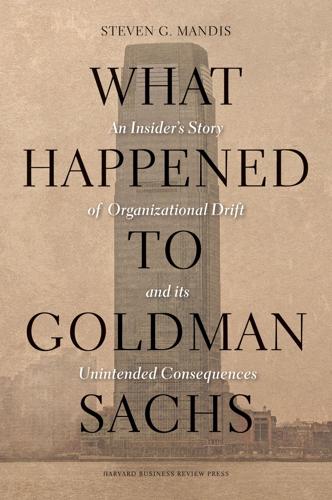
What Happened to Goldman Sachs: An Insider's Story of Organizational Drift and Its Unintended Consequences
by
Steven G. Mandis
Published 9 Sep 2013
In addition, Goldman’s community service and philanthropy are mentioned often in Goldman’s public filings. 6. C. D. Ellis, The Partnership—The Making of Goldman Sachs (New York: Penguin, 2008), 664. 7. B. McLean, “The Bank Job,” Vanity Fair, March 23, 2012, http://www.vanityfair.com/business/features/2010/01/goldman-sachs-200101. 8. http://www.thedailyshow.com/watch/thu-april-28-2011/exclusive-william-cohan-extended-interview-pt-2. 9. Stephen Colbert, “Greg Smith’s Goldman Sachs Op-Ed,” The Colbert Report (Viacom), March 14, 2012. 10. W. D. Cohan, “Doing God’s Work: How Goldman Became the Vampire Squid,” Institutional Investor, April 25, 2011, http://www.institutionalinvestor.com/Popups/PrintArticle.aspx?
…
D. Cohan, “The Rage over Goldman Sachs,” Time, August 31, 2009, http//www.time.com. 15. Ibid. 16. Ellis, The Partnership, 539. 17. W. D. Cohan, Money and Power: How Goldman Sachs Came to Rule the World (New York: Doubleday, 2010). 18. Cohan, “The Rage over Goldman Sachs.” 19. It was alleged that Maxwell stole money from Maxwell company pension plans by hiring Goldman to broker a trade between various Maxwell-controlled entities. See Endlich (Goldman Sachs, 137–160) for a detailed account of the relationship between Goldman and Robert Maxwell. 20. Endlich (Goldman Sachs, 197) notes, however, that management had “over-reserved in anticipation of such a financial charge” and was eager to put the case behind it. 21.
…
Perrow, Normal Accidents: Living with High-Risk Technologies (New York: Basic Books, 1984), 308. Chapter 5 1. Goldman Sachs Group, “Letter to Shareholders,” Annual Report 1999, http://www.goldmansachs.com/investor-relations/financials/archived/annual-reports/attachments/1999-annual-report.pdf. 2. W. D. Cohan, Money and Power: How Goldman Sachs Came to Rule the World (New York: Doubleday, 2011), 234. 3. B. McLean and A. Serwer, “Goldman Sachs: After the Fall,” Fortune, October 23, 2011, http://features.blogs.fortune.cnn.com/2011/10/23/goldman-sachs-after-the-fall-fortune-1998/. 4. Bankers Trust, Barclays, Chase, Credit Suisse First Boston, Deutsche Bank, Goldman Sachs, Merrill Lynch, J.P.
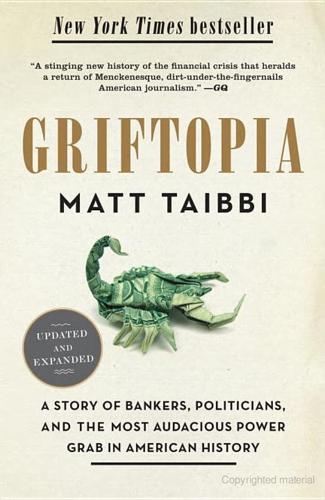
Griftopia: Bubble Machines, Vampire Squids, and the Long Con That Is Breaking America
by
Matt Taibbi
Published 15 Feb 2010
And far from being the best fruit of a democratic, capitalist society, it’s the apotheosis of the Grifter Era, a parasitic enterprise that has attached itself to the American government and taxpayer and shamelessly engorged itself on us all. THE FIRST THING you need to know about Goldman Sachs is that it’s everywhere. The world’s most powerful investment bank is a great vampire squid wrapped around the face of humanity, relentlessly jamming its blood funnel into anything that smells like money. In fact, the history of the recent financial crisis, which doubles as a history of the rapid decline and fall of the suddenly swindled-dry American empire, reads like a Who’s Who of Goldman Sachs graduates. Most of us know the major players: Henry Paulson, George Bush’s last Treasury secretary, who used to run Goldman and was the architect of a suspiciously self-serving plan to funnel trillions from the Treasury to a small list of his old friends on Wall Street.
…
My contribution to this was to launch a debate over whether or not it was appropriate for a reputable mainstream media organization to publicly call Lloyd Blankfein a motherfucker. This was really what most of the “vampire squid” uproar boiled down to. The substance of most of the freak-outs by mainstream financial reporters and the bank itself over the Rolling Stone piece was oddly nonspecific. Goldman spokesman Lucas van Praag called the piece “vaguely entertaining” and “an hysterical compilation of conspiracy theories.” Van Praag even made an attempt at humor, saying, “Notable ones missing are Goldman Sachs as the third shooter [in John F. Kennedy’s assassination] and faking the first lunar landing.” But at no time did the bank ever deny any of the information in the piece.
…
One, the state of Massachusetts in the person of Attorney General Martha Coakley launched an investigation of some of the mortgage-lending companies in her state, including Litton Loans—a wholly owned subsidiary of Goldman Sachs that ended up owning the smaller of Eljon’s two mortgage loans. Coakley accused Goldman Sachs of facilitating the kind of fraud practiced by Solomon Edwards by providing a market for these bad loans through the securitization process, by failing to weed out bad or unfair loans, and by failing to make information about the bad loans available to potential investors on the other end. By the time Coakley settled negotiations with Goldman Sachs, the latter had already been the beneficiary of at least $13 billion in public assistance through the AIG bailout, with $10 billion more coming via the Troubled Asset Relief Program and upwards of $29 billion more in cheap money coming via FDIC backing for new debt under another Geithner bailout program, the Temporary Liquidity Guarantee Program.
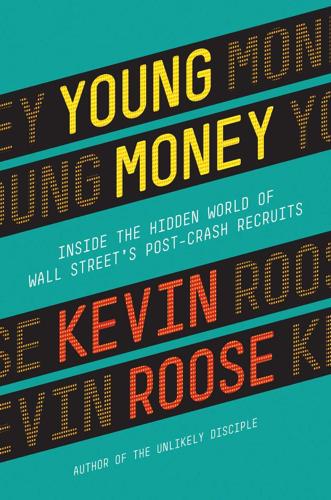
Young Money: Inside the Hidden World of Wall Street's Post-Crash Recruits
by
Kevin Roose
Published 18 Feb 2014
For full dramatic effect, I recommend the videos of students at Princeton interrupting recruiting sessions by J.P. Morgan and Goldman Sachs, which are available on YouTube. (Search “JP Morgan-Chase Mic-Checked at Princeton University” and “Goldman Sachs Anti-Recruitment Session at Princeton University.”) “students at Harvard and other schools protested the recruiting efforts of Dow Chemical”: “Students Will Protest Dow Chemical Today,” Harvard Crimson, October 25, 1967. “In the early 1970s, Stanford University banned Goldman Sachs from recruiting on campus for five years”: William D. Cohan, Money and Power: How Goldman Sachs Came to Rule the World, Doubleday, 2011. “And after the Iraq War in 2003, students at many top-tier schools protested Lockheed Martin, Halliburton, and other military and weapons companies”: Nicole Dungca, “SDS Protests CIA, Raytheon Recruiters,” Brown Daily Herald, September 24, 2008; Peter Schworm, “Students Switching Activism to Boardroom,” Boston Globe, August 13, 2007.
…
“an elite team of investors known throughout the bank as SSG—the Special Situations Group”: Christine Harper, “Goldman Sachs’s SSG: Lending or Trading?,” Bloomberg Businessweek, March 31, 2011. “a successful trader with several years of experience could easily make $500,000 or $600,000 a year”: A 2013 Bloomberg Businessweek article put the average Goldman Sachs worker’s pay for three months at $135,594, which translates to about $542,000 per year (Peter Coy, “At Goldman, the Average Pay for Three Months Is $135,594,” April 16, 2013). “The commodities division’s prestige could be traced to 1981, the year that Goldman bought J. Aron”: Susanne Craig, “The J. Aron Takeover of Goldman Sachs,” New York Times (DealBook), October 1, 2012
…
“Traders who came through on big axes would often get congratulated in the morning meetings, and often found their year-end bonuses increased as a result”: Greg Smith talks about Goldman’s “axe” culture as well, describing axes as “something…Goldman wants to clear from its inventory, making a compelling but not always completely accurate case for clients to buy them.” Smith also writes that “double GCs were sometimes awarded for axe-filling successes.” (Why I Left Goldman Sachs, p. 231.) “In July, it settled the Abacus fraud lawsuit”: Sewell Chan and Louise Story, “Goldman Pays $550 Million to Settle Fraud Case,” New York Times, July 15, 2010. “In September, it began to disband Goldman Sachs Principal Strategies”: Christine Harper and Saijel Kishan, “Goldman Sachs Said to Shut Principal Strategies Unit,” Bloomberg News, September 3, 2010. “the firm announced mediocre quarterly earnings that were down 40 percent”: Susanne Craig, “Lower Profit at Goldman Reflects Wall St.
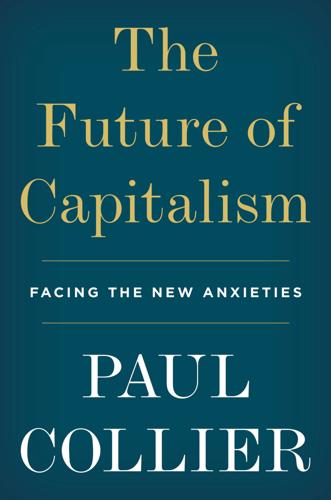
The Future of Capitalism: Facing the New Anxieties
by
Paul Collier
Published 4 Dec 2018
Led by Colin Mayer, Professor of Finance at Oxford University and the former Dean of its business school, the programme’s central proposition is that the purpose of business is to meet its obligations to its customers and its workforce. Profitability is not the objective; it is a constraint that has to be satisfied in order to achieve these objectives on a sustainable basis. Why has business gone so wrong, and how can public policy put it right? THE ETHICAL FIRM OR THE VAMPIRE SQUID? A great firm does not have to behave like a vampire squid.* Think of a large firm, perhaps Unilever, Ford or Nestlé. What do you think the typical employee of such a firm would tell you about its purpose? Do you imagine that they would say ‘to make money for the owners’? Few firms truly run themselves on such a philosophy.
…
I prepared to apologize for the limitations of my knowledge, but on the contrary he shook my hand and confirmed that shareholder value had become the management obsession in meeting after meeting. In his judgement, that loss of true purpose had destroyed the company. * This was the image used to critique Goldman Sachs. Whether this was a travesty of Goldman Sachs, recent research suggests that it is not a travesty of squids. They transpire to have the intelligent, asocial, greedy malevolence that economists have wrongly attributed to humans. * Bear Stearns itself was rescued by JP Morgan at the behest of the US Treasury, but the knowledge that it was bankrupt triggered a run on a far larger bank, Lehman Brothers, which was seen to be too-big-to-bail, but turned out to be too-big-to-fail without consequences that proved to be disastrous
…
Although those narratives were not specifically about firms, they probably helped to account for the predominance of the ethical firm. Remember: back then CEOs paid themselves only twenty times what they paid their workers. They now pay themselves 231 times what they pay their workers: the ethical firm has given way to the vampire squid. Times have changed; they need to change back again. 5 The Ethical Family The family is the most potent of all the entities that lift us beyond the individual. Husband and wife publicly bind themselves to reciprocal obligations. Sentiment also binds parents to their children. Parents care for their children, and often, many years later, children care for their parents, but the potential for reciprocity is seldom asserted as a right.

The Spider Network: The Wild Story of a Math Genius, a Gang of Backstabbing Bankers, and One of the Greatest Scams in Financial History
by
David Enrich
Published 21 Mar 2017
Goldman was accused of profiteering off struggling clients and even countries, of providing conflicted, self-serving advice, of distorting public markets for its own profits. “The world’s most powerful investment bank is a great vampire squid wrapped around the face of humanity, relentlessly jamming its blood funnel into anything that smells like money,” Rolling Stone journalist Matt Taibbi would write of Goldman in 2010. The Vampire Squid moniker stuck. Still, if you were in finance, Goldman exerted a gravitational pull like few other bodies. One day in spring 2008, Hayes got a message from an executive at Goldman: They were interested in hiring him; would he be willing to meet?
…
But Fisher was preoccupied with an unrelated problem. He had read a Goldman Sachs research note earlier that day about Libor. Fisher was no expert on the benchmark, but he knew its definition: It was the rate at which banks thought they could borrow money from each other. The Goldman report had gotten the definition wrong, describing Libor as the rate at which banks loaned money to each other. When Fisher noticed the error, it got him thinking: How widespread was the confusion? Libor was an integral part of the world’s financial plumbing, so how could the great Goldman Sachs misunderstand what the rate was supposed to be measuring?
…
See also specific bankers and traders CFTC Libor investigation, 270–71, 315–19, 322 culture of, 275, 336–37 FSA investigation, 338–39 government bailout, 164–65, 212 Hayes job offer, 60–61 history of, 80–81 Justice investigation, 323–25 Libor financial settlement, 369–70, 372–73 Libor system, 81–83 OFT investigation, 332–33 Pieri’s anti-Hayes bandwagon, 292–94 post-Hayes trading, 288–94 shareholder meeting, 149–51 switch trades, 169–77 “Umbrella” (song), 153 UniCredit Bank, 220 University of Bath, 67 University of California, 256 University of Delaware, 311 University of London, 447 University of Minnesota, 249–50 University of Nottingham, 14, 16, 21, 22, 335 University of Pennsylvania, 246–47 University of Southampton, 448 Vampire Squid, 157–58 Venice Beach, 209 Vogels, Frits, xi, 168, 335 Wall Street Journal, 6, 188–91 “Libor Fog: Bankers Cast Doubt on Key Rate Amid Crisis,” 190–91, 195, 202–3, 204–5 “Rate Probe Keys on Traders,” 346–47 “Study Casts Doubt on Key Rate,” 196–98, 201–2 Wallis, Deborah, 183, 192 Walsh, Andrew, 150–51 Wandsworth Prison, 444, 450 Waterloo Station, 98 We Need to Talk About Kevin (Shriver), 54 Weill, Sandy, 230 WestLB, 97, 98, 99, 133, 206 When Genius Failed (Lowenstein), 288 White, Paul, x, 283, 334–35 Whitehouse, Mark, 190–91, 196–98 Whitewater controversy, 268 Wikipedia, 207–8 Wiley, Stuart, xi, 107–8, 108n, 170, 214, 225–26 Wilkinson, Danny, xi, 126–30 background of, 127 fees and commissions, 132, 274 Hayes and, 128–29, 130, 155–56, 225–26, 352–54 Hayes firing, 304 Justice criminal charges, 394–95 Libor investigation, 335 FSA/CFTC interview, 352–54 Libor submissions, 99, 130, 132, 225–26, 274 Libor trial, 452–53, 455–56 music and DJing, 412 nicknames of, 126 SFO criminal charges, 404 suspension of, 343–44, 343n Williams, Andrew, 372 Williams, David, 348, 348n, 391 Willkie Farr & Gallagher, 400 Wilmot-Sitwell, Alex, x, 231, 233, 372–73 Windsor Pub, 152–53, 313 Wink, Angus, xii, 173–74, 174n Wiston House, 256–57 World Darts Championship, 401–2 World Trade Center, 120–21, 202 Yomiuri Giants, 93 Youle, Thomas, 249–53 “Does the Libor reflect banks’ borrowing costs?”
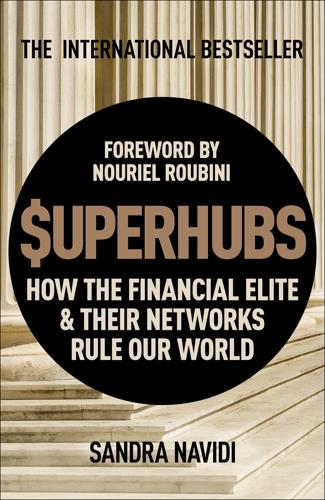
SUPERHUBS: How the Financial Elite and Their Networks Rule Our World
by
Sandra Navidi
Published 24 Jan 2017
The central bank governor of the Bank of England during the crisis was Mervyn King, who had also once taught in MIT’s economics department. It is quite incredible how much our world has been shaped by the few who attended the same school. The epitome of the old boys’ network is Goldman Sachs. It is the most exclusive of all exclusive clubs and artfully illustrates how the power-laws of network science correlate with actual network power. Due to the fact that Goldman always seems to make money regardless of the circumstances, it has been vilified as the “great vampire squid wrapped around the face of humanity”17 and alleged to have caused as well as profited from various financial crises. Goldmanites are everywhere, as the firm hires former high-level public sector employees, and partners leave the firm to take public office.
…
In the time leading up to the financial crisis, Robert Rubin, previously co-CEO of Goldman Sachs, served as secretary of the U.S. treasury under President Bill Clinton. During the crisis, Hank Paulson, then CEO of Goldman Sachs, became the next U.S. treasury secretary. The president of the European Central Bank, Mario Draghi, was once vice chairman and managing director of Goldman Sachs International. Mario Monti, prime minister of Italy from 2011 to 2013, worked as an adviser for Goldman Sachs. Robert Zoellick went from being Goldman Sachs’s head of international affairs to president of the World Bank. From there he returned to Goldman and became chairman of the international advisory board.
…
Speaking of Germany, its government was heavily criticized for providing too much top-level government access to Goldman Sachs, which the political opposition labeled the “bonus program for investment bankers.” Prior Goldman Sachs employees have also obtained high-level government positions throughout the world. Numerous other influential and famous Goldmanites include John Thain (former chairman and CEO of CIT Group, former president and co-CEO of Goldman Sachs), Jon Corzine (CEO of MF Global, former U.S. senator of New Jersey, former CEO of Goldman Sachs), Duncan Niederauer (former CEO of NYSE Group, former partner at Goldman Sachs Group), Joshua Bolten (White House chief of staff to U.S.
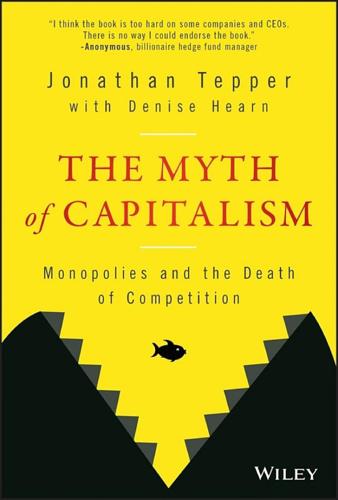
The Myth of Capitalism: Monopolies and the Death of Competition
by
Jonathan Tepper
Published 20 Nov 2018
For example, cable companies in the United States possess a local monopoly and have been using their market power to overcharge the typical household about $540 per year, according to the nonprofit Consumer Federation of America.11 Not only are prices high, but cable companies also have long history of throttling sites and content they don't like to restrict use of the internet.12 Comcast has throttled peer-to-peer services like Bitorrent under the guise of managing bandwidth.13 Buffett and Thiel's thinking has not gone unnoticed. Investment banks like Goldman Sachs (also known as the Vampire Squid of Wall Street due to its business attitude) have recommended to clients that they should welcome oligopolies and buy them. Oligopolies may have a bad reputation for pillaging consumers, but they are attractive because in Goldman Sach's view they have “lower competitive intensity, greater stickiness, and pricing power with customers due to reduced choice, scale-cost benefits including stronger leverage over suppliers, and higher barriers to new entrants all at once.”
…
Ogden, 138 Gig economy, rise, 74 Gini coefficients, 220f Glasses, duopolies, 124–125 Global meat processing firms, ownership timeline (changes), 134f Global wealth pyramid, 218f Global Wealth Report (Credit Suisse), 218 “Goals of Antitrust Policy, The” (Bork), 157–158 Golden parachutes, usage, 192 Goldman Sachs, 191–192 federal government, revolving door, 189–190, 190f Vampire Squid of Wall Street, 5 Gonzaga, Pedro, 226 Google AdWords, 88 Apple, duopoly, 123 apps, sale (determination), 91–92 competition impact, 95 data theft, 89–90 duopoly, 4 information superhighway dominance, 108 lobbying efforts/expenses, 95–96 market dominance, 123–124 market position abuse, 90 monopoly, 39–40 motto, usage (cessation), 93 news/information source, problems, 112–113 product search, favoritism, 89 profitability/power, 99 protestors, 231 search dominance, 88, 107 technology, secrecy, 108 threat, 108 workers, color-coded caste system, 39–40 Gottesman, Sandy, 2 Grantham, Jeremy, 223 Graper, Mary, 176 Great Depression, 16–17, 78, 144–145, 182 Great Suppression, 84f Greenwald, Bruce, 179 Gros Michel bananas, loss, 59–60 Gross domestic product (GDP), corporate profit percentage, 222–223 Group purchasing organizations (GPOs), oligopolies, 130–131 Grullon, Gustavo, 8, 13, 47, 161, 163, 224 Gupta, Rajat, 14 Gutiérrez, Germán, 56 H Haldane, J.B.S., 49 Hale, Robert Lee, 92 Haltiwanger, John, 50 Hanauer, Nick, 231–232 Hansen, Alvin, 56 Hayek, Friedrich, 153, 171, 234, 238 Health expenditure, life expenditure (contrast), 132f Health insurance, oligopolies, 30–31 HealthTrust, market dominance, 130 Hedge fund managers, training, 15 Hell's Cartel (Jeffreys), 147 Herfindahl-Hirschman Index (HHI), 33, 243 Hierarchy of needs, 76f High-income inequality, 215 High speed Internet, monopolies/local monopolies, 116–117 Hitler, Adolf (accession), 148–149 H.J.
…
Gary Cohn became the second Goldman Sachs executive to head the National Economic Council. Former Goldman Sachs investment banker Stephen Bannon was appointed as Trump's chief strategist, and Goldman Sachs partner Steven Mnuchin was nominated for Treasury Secretary. Trump economic adviser Anthony Scaramucci worked for Goldman Sachs as a vice president of wealth management.82 Goldman Sachs has by far been the biggest winner of the revolving door in Washington. During the financial crisis and the bailouts, Goldman Sachs had at least four dozen former employees, lobbyists, or advisers operating in the highest reaches of power both in Washington and around the world.
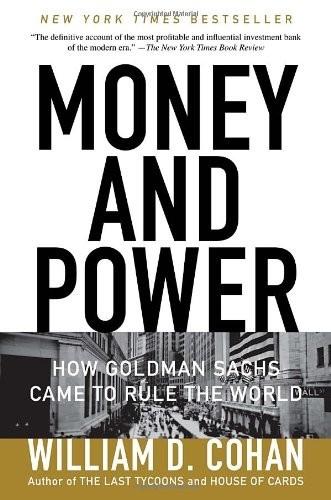
Money and Power: How Goldman Sachs Came to Rule the World
by
William D. Cohan
Published 11 Apr 2011
“That is why we are able to say that whether it failed or not, AIG would have had no material direct impact on Goldman Sachs,” he said. The call seemed to raise more questions than it answered—among the very people it was designed to pacify: the journalists listening in on behalf of the American people. That frustration—and confusion—showed up first in a July 2009 issue of Rolling Stone magazine in a now-classic bit of conspiracy-theory journalism written by reporter Matt Taibbi. “The first thing you need to know about Goldman Sachs is that it’s everywhere,” Taibbi wrote. “The world’s most powerful investment bank is a great vampire squid wrapped around the face of humanity, relentlessly jamming its blood funnel into anything that smells like money.”
…
The combination of these two genetic strains—the ability to make boatloads of money at will and to appear to manage conflicts that have humbled, then humiliated lesser firms—has made Goldman Sachs the envy of its financial-services brethren. But it is also something else altogether: a symbol of immutable global power and unparalleled connections, which Goldman is shameless in exploiting for its own benefit, with little concern for how its success affects the rest of us. The firm has been described as everything from “a cunning cat that always lands on its feet” to, now famously, “a great vampire squid wrapped around the face of humanity, relentlessly jamming its blood funnel into anything that smells like money,” by Rolling Stone writer Matt Taibbi.
…
Taibbi blamed Goldman for a multitude of financial sins, including the Great Depression, the Internet bubble, the housing bubble, the explosion in the per-gallon price of gasoline, as well as for “rigging the bailout” to its advantage. The metaphor of Goldman being a “great vampire squid” soon became so ubiquitous that even Blankfein could not ignore it. “That Rolling Stone article oddly enough tapped into something,” he said in an interview in August 2009. “I thought it was so over the top that I actually read it as a gonzo piece of over-the-top kind of writing that some people found fun to read. That’s how I saw it. But then you had other people sort of taking stuff as if Goldman Sachs burned down the Reichstag, fired on Fort Sumter, shot the archduke Ferdinand, all that kind of stuff.”
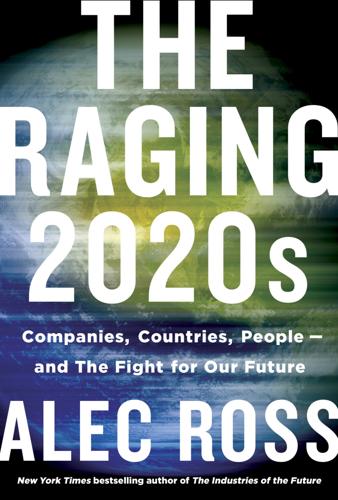
The Raging 2020s: Companies, Countries, People - and the Fight for Our Future
by
Alec Ross
Published 13 Sep 2021
There are few organizations that have had more ink spilled over their power and market influence than Goldman Sachs, arguably the most powerful investment bank in the world. Journalist Matt Taibbi famously characterized the bank as “a great vampire squid wrapped around the face of humanity, relentlessly jamming its blood funnel into anything that smells like money.” Goldman Sachs has become the very caricature of Wall Street power, but perhaps to the surprise of its more radical critics the company is now wielding that power to push for more diversity at the highest levels of the private sector in industries the world over. At the 2020 World Economic Forum, Goldman Sachs CEO and chairman David Solomon announced that the company would underwrite initial public offerings (IPOs) only for American and European companies that have at least one board member who is a woman or a person of color.
…
“It’s not perfect,” he noted, “but it sends a very strong message.” The idea that Goldman “the great vampire squid” Sachs is using its power for good cuts against the grain of today’s narrative and hashtag snark commentary. That makes it all the more consequential. When companies like Walmart and Goldman Sachs take a stand on social issues, they usually justify it on the basis of values and social responsibility, but more often than not, those decisions boil down to a simple economic calculation: Do the long-term benefits outweigh the short-term costs? For Goldman Sachs, the answer was yes. Positioning itself on the right side of history was an investment in the long term.
…
Journalist Matt Taibbi famously: Matt Taibbi, “The Great American Bubble Machine,” Rolling Stone, April 5, 2010, https://www.rollingstone.com/politics/politics-news/the-great-american-bubble-machine-195229/. In 2018 and 2019, some sixty companies: Claire Zillman, “The U.S. Doesn’t Mandate Diverse Boardrooms—but Now Goldman Sachs Does,” Fortune, January 23, 2020, https://fortune.com/2020/01/23/goldman-sachs-board-gender-quota-david-solomon/. Solomon fought to ensure: Jena McGregor, “Goldman Sachs Says It Wants Half of Its Entry-Level Recruits to Be Women,” Washington Post, March 18, 2019, https://www.washingtonpost.com/business/2019/03/18/goldman-sachs-says-it-wants-half-its-entry-level-recruits-be-women/. Certain energy companies: Gregg Lemkau, interview with Alec Ross, June 2, 2020.
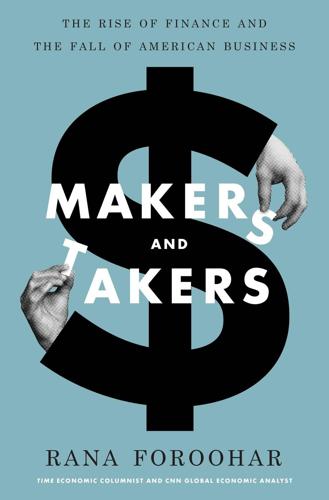
Makers and Takers: The Rise of Finance and the Fall of American Business
by
Rana Foroohar
Published 16 May 2016
In April 2011, journalist Frederick Kaufman wrote an article for Foreign Policy magazine titled “How Goldman Sachs Created the Food Crisis,” which put the blame squarely on Wall Street.10 Kaufman outlined many of the headline statistics about just how financialized food and all sorts of other commodities had become. Since 2000 there has been a fiftyfold increase in dollars invested into commodities-linked index funds. It was a shift that was due to several things: the creation of a commodity index fund by Goldman Sachs in 1991, which allowed raw materials to become securities that could be bought and sold by investors; the deregulation of commodities markets in 2000, which poured gasoline on that process; the financial crisis of 2008, which scared everyone out of stocks and drove investors into “safety” bets like raw materials; and the beginning of the Federal Reserve’s quantitative easing program the following year, a $4.5 trillion money dump that was meant to help Main Street but ended up giving Wall Street a lot of easy money to burn.
…
Yet interestingly, none of the public comments about the matter mentions Goldman or any other banks, and public relations representatives at the companies declined to comment for this book about the banks’ involvement in the issue. No wonder. Coke has been a longtime investment banking client of Goldman Sachs, and at the time of the LME complaint, it had recently hired the bank to advise it on a $12 billion acquisition.68 “If I were Coca-Cola’s general counsel, I wouldn’t want my company to start a big fight with Goldman Sachs, either,” says Omarova. “What if we need to raise debt on the public markets tomorrow and need an underwriter? What if we plan a merger and need transaction advice? What might Goldman research analysts do to our share price if they wanted to?
…
But as the examples above indicate, formal lobbying is only one facet of Wall Street power in Washington. Jamie Dimon isn’t a lobbyist. Nor is Goldman Sachs chief Lloyd Blankfein, nor are any of the other top financiers who regularly consort with the people who regulate them. Yet these and other top bankers, along with their trade groups and lawyers, were among those who were constantly taking meetings with the federal agencies and regulators that were crafting the Dodd-Frank reform rules. As just one example of many, in the year after Dodd-Frank’s passing, Goldman Sachs (the most active among financial institutions) paid eighty-three visits to regulators to discuss topics like derivatives reform.11 In 2013, Duke University academic Kimberly Krawiec published a startling research paper analyzing more than eight thousand public comment letters received by the Financial Stability Oversight Council as it prepared to study the ways of implementing the Volcker Rule, a particularly contentious piece of the Dodd-Frank reform that aimed to reinstate some of the spirit of the Glass-Steagall legislation by separating risky proprietary trading from federally insured commercial banking.
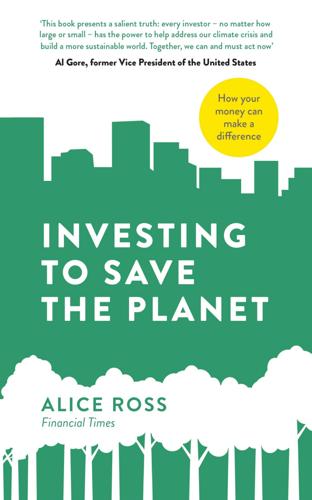
Investing to Save the Planet: How Your Money Can Make a Difference
by
Alice Ross
Published 19 Nov 2020
Any unauthorized distribution or use of this text may be a direct infringement of the author’s and publisher’s rights and those responsible may be liable in law accordingly. 1 A Short History of Green Investing 1 Goldman Sachs would later achieve notoriety in the wake of the global financial crisis of 2008 after a scathing article in Rolling Stone magazine likened it to a great ‘vampire squid’ whose aim was to create ‘pure profit for rich individuals’. 2 Gore was a joint winner with the Intergovernmental Panel on Climate Change (IPCC). The prize was awarded for their efforts to ‘build up and disseminate greater knowledge about man-made climate change, and to lay the foundations for the measures that are needed to counteract such change’. 3 Running Out of Gas: Does Divestment Work?
…
If we invest our money in the right way, we can help to combat climate change and feel a sense of control in an uncertain world. This book will help you to do that. 1 A Short History of Green Investing When David Blood told his colleagues in 2003 that he was resigning to start a sustainable investment company, they laughed at him. Blood was a senior banker, working as the head of asset management at Goldman Sachs. His clients were among the largest investors in the world. But back then, not many of them were interested in investing in climate change solutions.fn1 Most experts at that time, Blood recalls, thought that sustainable investing meant limiting your horizons. In other words, it was about being a do-gooder rather than an investor: people could choose not to invest in fossil fuel companies, but they’d make less money as a result.
…
In its 2018 annual report, Shell noted the emergence of the divestment movement and admitted that, if it continued as it had, it could have ‘a material adverse effect’ on both the company’s share price and its ability to access equity capital markets. If investors choose to divest for longer-term economic reasons, rather than primarily due to a moral stance, this also turns one of the main arguments against divestment on its head: that it can harm your investment returns. We saw this when David Blood’s colleagues at Goldman Sachs laughed at him for moving into sustainable investment. The general rule of thumb in investment theory is that spreading your risk across as many sectors and asset classes as possible is the best strategy. Some investors worry that restricting your investment universe – by cutting out fossil fuel companies, for example – could harm your financial returns.
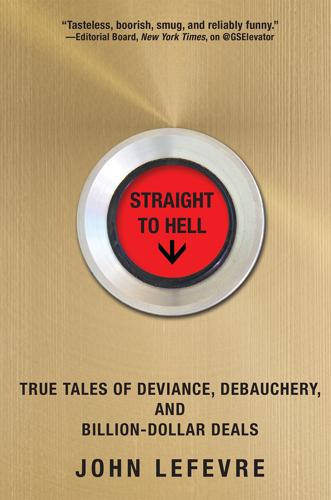
Straight to Hell: True Tales of Deviance, Debauchery, and Billion-Dollar Deals
by
John Lefevre
Published 4 Nov 2014
In the drunken haze of that subsequent evening, @GSElevator was born—“Things heard in the Goldman Sachs elevators do not stay in the Goldman Sachs elevators. Email me what you hear.” The premise was simple—to illuminate Wall Street culture in an entertaining and insightful way. I chose Goldman Sachs because of their position as public enemy #1, and people’s fascination with “vampire squids” and the absurdity of Lloyd Blankfein claiming to be “doing God’s work.” More specifically, in having recently gone through the arduous process of being offered the prestigious job of Head of Asia Debt Syndicate at Goldman Sachs (a hiring that was deemed newsworthy by Bloomberg and others), I found their culture to be an amplified version of broader banking culture.
…
One day, Earpiece doesn’t show up. He doesn’t respond to emails or texts; he’s gone. Many hope he’s dead. Rumors have it that he’s resigned to go to Goldman Sachs and run the loan syndicate team over there (a team that is later supposed to report to me). Thank fucking Christ; they can have him. We’re celebrating. There are two problems. First, our degenerate head of , Wisal Lari, misses having someone so dedicated to kissing his ass. Second, Goldman Sachs is famous for rigidly refusing to hire someone and promote them at the same time. For example, if there’s a well-regarded associate or VP at a real bank, a second-tier house can easily come in and steal them away with the promise of a guarantee and an immediate promotion in rank.
…
We started recruiting many of the new analysts for Asia from the pool of résumés that were sent in to the private bank by their ultra-high-net-worth clients looking for favors. JPMorgan, Goldman Sachs, HSBC, UBS, Morgan Stanley, and most other firms would do the same thing through their respective private wealth management divisions. It became the running joke any time one of our counterparts at another bank brought a new analyst to a meeting or roadshow luncheon. “So, who is his [or her] father?” was the first question, unless she was hot, then it was “Is she single?” Many of the kids we hired were so dumb and undeserving (there are plenty of Princelings from Harvard, but they only want the cachet of Morgan Stanley or Goldman Sachs) and it frustrated New York so much so that they “coincidentally” decentralized recruiting and training, so that the hiring for Asia was done out of Asia.
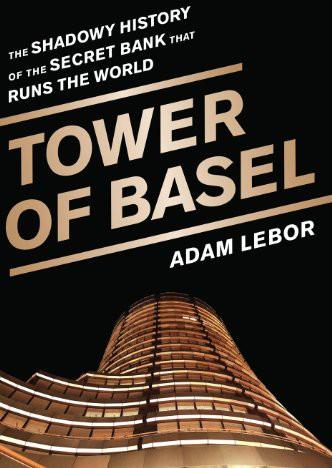
Tower of Basel: The Shadowy History of the Secret Bank That Runs the World
by
Adam Lebor
Published 28 May 2013
The IMF, the World Bank, the European Commission, and the BIS itself are also members of the FSB, as are three of the most powerful committees hosted at the BIS: the Basel Committee on Banking Supervision, the Committee on the Global Financial System, and the committee dealing with payment and settlement systems. The writer Matt Taibbi once memorably described Goldman Sachs, the giant investment bank, as a “vampire squid.”8 The BIS is now the vampire squid of the regulatory world, hosting a myriad of committees that in turn spawn a raft of subcommittees, many of which are composed of the same central bankers and officials, each producing reams of reports that are passed back and forth from Basel to national central banks and governments in an endless merry-go-round of resolutions and recommendations.
…
His time in Paris gave him a privileged insight into the workings of international finance and diplomacy and a network of coveted contacts. Dulles’s client list during the 1920s read like a who’s who of American finance: J. P. Morgan; Kuhn, Loeb & Co.; Harris, Forbes & Co.; Brown Brothers; W. A. Harriman; and Goldman Sachs. Dulles arranged tens of millions of dollars’ worth of loans to clients, including to the cities of Munich, Frankfurt, Nuremberg, Berlin, and Hanover, and to the Union of German Mortgage Banks, the Berlin City Electric Company, Hamburg Street Railways, and the State of Prussia. Dulles also worked on the Dawes Plan German Loan in 1924 and the German Government International Loan of 1930 that had been instigated by the Young Committee.5 Wall Street in the 1920s was possessed by a near-mania to lend to Germany.
…
He was citizen of both a neutral country—the United States—and of the world’s newest hinterland—transnational finance. McKittrick had worked for Higginson & Company, the British subsidiary of Lee, Higginson & Company—a renowned Boston investment house. The bank no longer exists, thanks in part to McKittrick, but in its heyday it was richer and more prestigious than Goldman Sachs and Lehman Brothers. Born in St. Louis, McKittrick had graduated from Harvard in 1911. He moved to Italy where he worked for the foreign arm of the National City Bank of New York, before joining the US Army in 1918. He was sent to Liverpool, where he was seconded to British military intelligence, to check that there were no spies using the docks to pass in and out of Britain.
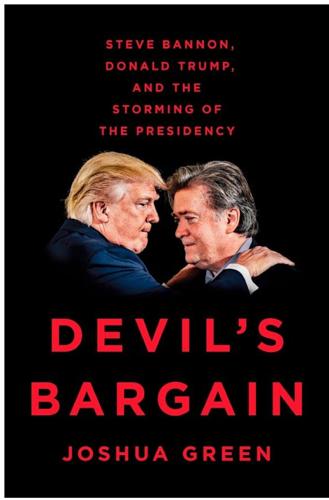
Devil's Bargain: Steve Bannon, Donald Trump, and the Storming of the Presidency
by
Joshua Green
Published 17 Jul 2017
By 1986, Bannon’s first full year on Wall Street, Milken had become Wall Street’s most notorious villain and Drexel Burnham its most profitable investment bank, clearing $545.5 million on revenues of $4 billion. More important for Bannon and Goldman Sachs, Milken and his army of raiders had struck terror in the hearts of the chief executives of America’s finest corporations. “Everything in the Midwest was being raided by Milken,” said Bannon. “It was like a firestorm.” The attacks by Milken had a corollary effect on the companies he targeted: they needed help staving off the barbarians at the gates. This, too, created profitable new business opportunities. Goldman Sachs, not yet evolved into the money-grubbing “vampire squid” it would later become, was a white-shoe firm that wouldn’t deign to represent corporate raiders in hostile takeover bids.
…
He was clearly intelligent, had a manic charisma, and espoused a distinct and unusual politics. He also claimed to have been a Goldman Sachs investment banker and Hollywood producer, recently returned from running a video-game empire in Hong Kong. I quickly sized him up as a colorful version of a recognizable Washington character type: the political grifter seeking to profit from the latest trend. No politician was hotter in 2011 than Palin. And Washington was rife with Tea Party con men. We agreed to stay in touch (grifters can be good sources). Later on, out of idle curiosity as much as anything else, I called Goldman Sachs to see if Bannon had really worked there. He had.
…
Bannon walked away convinced that, despite his grades and class standing, he might not get an interview anywhere, much less get a job. He had little choice but to keep trying. A short while later, a team from Goldman Sachs arrived on campus. Bannon dutifully attended a presentation delivered by Kevin Kennedy, a young vice president who would go on to become a senior partner at the firm. Thirty years later, Bannon could still summon the details of Kennedy’s no-bullshit pitch to the HBS students for a Goldman Sachs that was then still a close-knit, privately held partnership. “He says, ‘We’re a very hard-working place. There are no stretch limos outside. We’re very middle class.
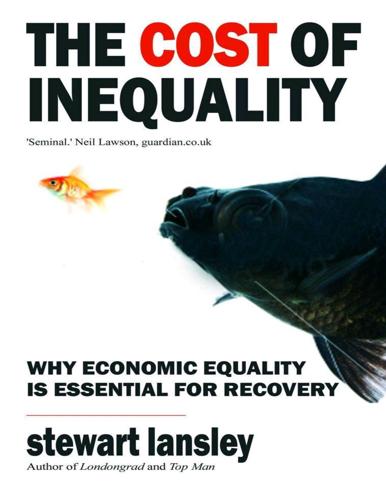
The Cost of Inequality: Why Economic Equality Is Essential for Recovery
by
Stewart Lansley
Published 19 Jan 2012
The proportion of landowners and industrialists with inherited wealth slipped.355 Although there were some financiers in the 1990 list—from the break-up king, James Goldsmith to the legendary financier Tiny Rowland—the number of City bankers and financial deal-makers has been rising sharply. In 2010, nearly a fifth of the richest 1000—including 51 hedge fund owners—made their money through banking and finance whereas only 11 per cent made it in industry or engineering. Thirteen partners at the American investment bank, Goldman Sachs—famously described by Rolling Stone magazine as a “vampire squid wrapped around the face of humanity”—made it into the top 1000.356 A certain level of finance-led industrial restructuring that forges more competitive and sustainable companies is inevitable and necessary. Mergers sometimes make sound business sense, while some companies need stronger management.
…
It later emerged that Goldman Sachs, the investment bank handling the deal, had sold the mortgage-backed security—largely a pool of sub-prime mortgages called Abacus—onto unsuspecting clients in full knowledge that if Paulson was right these customers would make huge losses. The losses helped bankrupt the German Bank IKB and cost the Royal Bank of Scotland, and the British taxpayer, close to £600 million. Paulson, with Goldman Sachs, was deliberately creating toxic assets in order to profit from their failure, effectively a massive institutional transfer of wealth. Goldman Sachs was later fined $550 million—the largest such fine in history, $250 million to be returned to investors and $300 million paid to the U.S.
…
Mark McGoldrick, nicknamed ‘Goldfinger’, who ran a ‘special-situations’ fund for Goldman Sachs—invested in a variety of obscure and illiquid investments, from Japanese golf courses to Thai auto loans—earned $70 million in 2006, but left a year later to set up his own hedge fund. The investment banks have always been highly guarded about the role of such trading. Although they have also claimed that the desks played a minor role, they accounted for a significant proportion of revenue at the height of the financial boom. In the case of Goldman Sachs, a study by the University of Massachusetts found that such trading accounted for some 64 per cent of the bank’s net revenue in 2006 and 2007.339 Another key way in which the increasing power of the City has been bad news for other sectors of the economy has been through the growing and to most, disproportionate, rewards available in finance.
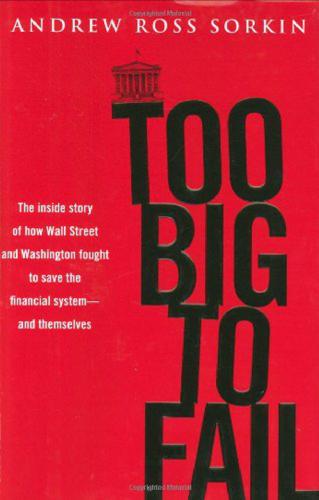
Too big to fail: the inside story of how Wall Street and Washington fought to save the financial system from crisis--and themselves
by
Andrew Ross Sorkin
Published 15 Oct 2009
Moore, “AIG CEO Demands Apology from Mad Money’s Jim Cramer,” WSJ/ Deal Journal, October 20, 2008. “Is Goldman Sachs Evil?” Joe Hagen, “Is Goldman Sachs Evil? Or Just Too Good?” New York, July 26, 2009. “great vampire squid wrapped”: Matt Taibbi, “The Great American Bubble Machine,” Rolling Stone, July 13, 2009. Goldman reported a profit of $5.2 billion: On April 13, Goldman reported net earnings of $1.81 billion for its first quarter. Three months later, its second-quarter earnings soared to $3.44 billion. See http://www2.goldmansachs.com. Goldman’s VaR rising to record high: Christine Harper, “Goldman Sachs VaR Reaches Record on Risks Led by Equity Trading,” Bloomberg, July 15, 2009.
…
While the fact has often been overlooked, Geithner, by his very nature—as has been demonstrated throughout this book and in his subsequent policies as Treasury secretary—is as much a proactive deal maker as Paulson, if not more so. Still, the conspiracy theories kept coming, and the narratives grew more elaborate. “Is Goldman Sachs Evil?” asked the cover of New York magazine. The writer Matt Taibbi created a new popular metaphor for the firm, describing Goldman in a Rolling Stone article as a “great vampire squid wrapped around the face of humanity, relentlessly jamming its blood funnel into anything that smells like money.” Months after the TARP infusion, Goldman reported a profit of $5.2 billion for the first half of 2009.
…
Blankfein,” New York Times, May 15, 1983. the firm acquired J. Aron in late October 1981: On October 29, 1981, Goldman Sachs announced its acquisition of J. Aron & Company for an undisclosed amount (at the time industry experts said it was “slightly more than $100 million”). H. J. Maidenberg, “Goldman Sachs Buys Big Commodity Dealer,” New York Times, October 30, 1981. they pounded their desks with their fists and threw their: Endlich, Goldman Sachs, 96. “You can call yourself contessa, if you want”: Bethany McLean, “Rising Star: Lloyd Blankfein, Goldman Sachs,” Fortune, February 6, 2006. Winkelman first noticed Blankfein: Craig, “How One Executive Reignited,” Wall Street Journal.
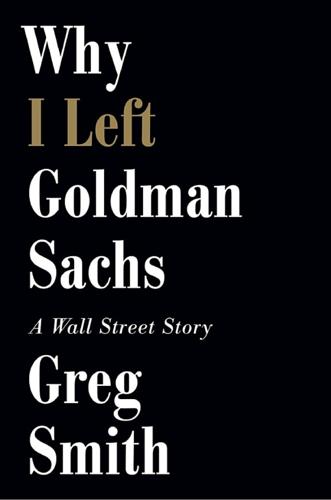
Why I Left Goldman Sachs: A Wall Street Story
by
Greg Smith
Published 21 Oct 2012
Ever since the federal government had bailed out the banks thanks to TARP, there had been murmurings in the world at large that someone needed to be held accountable for the crisis; for months there had been the sense of a gathering lynch mob. A series of big articles—in Rolling Stone, New York magazine, and Time, among others—castigated Wall Street in general, and Goldman Sachs in particular, for surviving and thriving on the backs of U.S. taxpayers, for using bailout money to make big bets, then using the winnings to award executives obscenely big bonuses. When I heard the term vampire squid, popularized by Matt Taibbi in Rolling Stone, I was repulsed by it. Propaganda, I thought. It angered me. Why don’t they ever write about 10,000 Women or 10,000 Small Businesses, and the way the firm is helping to nurture the next generation of entrepreneurs, or any of the other philanthropic endeavors we fund and lend our expertise to?
…
The risk was simply this: if Goldman Sachs went bankrupt, the client’s money might vaporize. And what were the chances of Goldman Sachs—Goldman Sachs—going bankrupt? Wasn’t going to happen. Bear Stearns had been foolish to tie up so much of its business in subprime mortgages. (What had been really foolish was betting so much on subprime mortgages, rather than against them…) I told my clients, “Look, you have to make a determination. Do you think Goldman Sachs is going to go bankrupt? If the answer to that is yes, you should not do this funding trade. However, if you believe that in a year’s time Goldman Sachs will still be around, you should do this trade, because you will outperform your benchmark by two percent, and that two percent will make your year.”
…
People at work were freaked out, but I was moved by how everybody pulled together and supported one another—and our clients. The overriding message was “Now is the time we differentiate ourselves. This is where Goldman Sachs becomes Goldman Sachs. Let’s be ultra-attentive to our clients; let’s help them get back on their feet, even if it doesn’t benefit us immediately. Because that’s what the clients are going to remember.” The message was classic Goldman Sachs, and the reason it could be proclaimed so strongly is because the old guard was still there. Many of the pre-IPO partners were still in place. This was early in Hank Paulson’s tenure as sole CEO; he had recently forced out Jon Corzine.
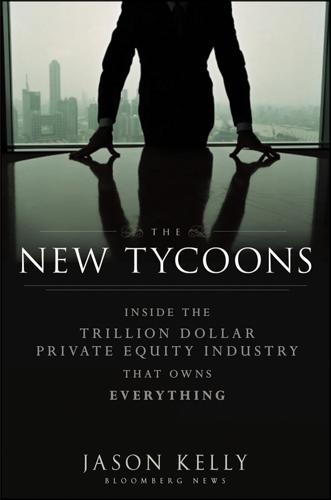
The New Tycoons: Inside the Trillion Dollar Private Equity Industry That Owns Everything
by
Jason Kelly
Published 10 Sep 2012
In the era of Twitter, blogs, and constant instant commentary, Schwarzman is shorthand for the private equity industry and its excesses, real and perceived. A posting in the online magazine Salon in September 2011 referred to him as “a living symbol of post-industrial late capitalism’s gaudy depravity.”2 Later in 2011, no less than Matt Taibbi, the Rolling Stone writer who famously described Goldman Sachs as “a great vampire squid wrapped around the face of humanity” characterized Schwarzman thusly: “one of the more uniquely abhorrent, self-congratulating jerks in the entire world.”3 What perpetuates Schwarzman’s profile is his tendency to go off script. At a meeting in July 2010 for a nonprofit organization, he drew an unfortunate comparison between private equity’s fight with Washington over tax policy and World War II.
…
While private-equity executives often contend that they are not part of Wall Street, a point made repeatedly during the depths of the financial crisis, during the height of the Occupy movement, and to every regulator or legislator who would listen during all of that time, the debt part of the equation inextricably ties buyout firms to investment banks and other lenders, as well as hedge funds. Big banks like JPMorgan and Goldman Sachs have evolved into the primary providers of debt for leveraged buyouts and as the private equity industry has grown, groups of bankers devoted to what bankers call financial sponsors (just another name for private-equity firms) have flourished, especially when deals were coming fast and furious.
…
Farr tapped Canada Pension Plan, with its hearty appetite for so-called co-investments that give investors the ability to put more money into a deal, for lower fees. Farr additionally convinced Wellington Capital Management, an existing public shareholder of Dollar General, to buy into the new deal. Goldman Sachs and Citigroup, which were helping arrange debt financing, ponied up cash from their private-equity arms. KKR had the money it needed. “Everyone saw tangibly how this could work,” Farr said. “Before that, there were a lot of skeptics.” The combined equity was about 37 percent, a substantial portion by historical standards (in KKR’s seminal RJR deal, the company put up less than 10 percent), but it still left more than 60 percent of the deal to be funded through borrowed money.
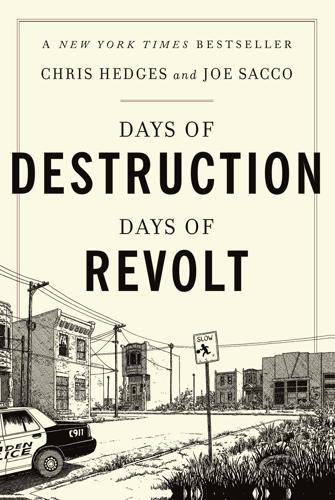
Days of Destruction, Days of Revolt
by
Chris Hedges
and
Joe Sacco
Published 7 Apr 2014
Despising, For you, the city, thus I turn my back; There is a world elsewhere.44 Faces appeared to me moments before protestors from Occupy Wall Street and I were arrested on a windy November afternoon in front of Goldman Sachs. They were not the faces of the smug Goldman Sachs employees, who peered at us through the revolving glass doors and lobby windows, a pathetic collection of middle-aged fraternity and sorority members. They were not the faces of the blue-uniformed police with their dangling plastic handcuffs, or the thuggish Goldman Sachs security personnel, whose buzz cuts and dead eyes reminded me of the Stasi. They were not the faces of the demonstrators around me, the ones with massive student debts and no jobs, the ones weighed down by their broken dreams, the ones whose anger and betrayal triggered the street demonstrations and occupations for justice.
…
War brings with it a host of horrors, but the worst is always the human detritus that war and famine leave behind, the small, frail bodies whose tangled limbs and vacant eyes condemn us all. The wealthy and the powerful, the ones behind the glass at Goldman Sachs, laughed and snapped pictures of us as if we were an odd lunchtime diversion from commodities trading, from hoarding and profit, from the collective sickness of money worship, as if we were creatures in a cage, which in fact we soon were. Goldman Sachs’ commodities index is the most heavily traded in the world. The financial firm hoards futures of rice, wheat, corn, sugar, and livestock and jacks up commodity prices by as much as two hundred percent on the global market so that poor families can no longer afford basic staples and literally starve.
…
When prices swell, the farmer loses money because he sells less, the cereal company loses money because corn is more expensive, and finally the consumer loses money because food is more expensive. Goldman Sachs in 2003 convinced the government to lift the position limits Roosevelt had set up in the CEA, despite the evident danger. It argued that, like the farmer or the cereal company, it was at the whim of fluctuating prices, that position limits discrimination against the speculators who took on the same risk. The government conceded, allowing Goldman Sachs to buy up all the futures contracts and generate an artificial commodities bubble. So from 2003 to 2008, the commodities index market increased by a factor of twenty-five, from $13 billion to $317 billion.

The Corruption of Capitalism: Why Rentiers Thrive and Work Does Not Pay
by
Guy Standing
Published 13 Jul 2016
Yet executives of those firms continue to move into senior government positions that make economic policy nationally and internationally. Many of the top spots have been taken by people from just one Wall Street institution, investment bank Goldman Sachs, once dubbed by Rolling Stone magazine ‘the vampire squid’.22 These unelected technocrats are running the global economy. Mario Draghi, ex-Goldman Sachs and president of the European Central Bank, instituted the policy of quantitative easing that has enriched the rentiers and has called for more powers for the unelected ECB to force countries to undertake structural reforms in return for aid.
…
The United States must lead global financial reform efforts, and we must start by getting our own house in order. In short, the former CEO of Goldman Sachs, who was in charge of economic policy, had been spectacularly wrong. But he was not required to resign; he stayed in office until 2009. The Canadian Governor of the Bank of England, Mark Carney, was also previously employed by Goldman Sachs. William Dudley, chair of the Federal Reserve Bank of New York, is another Goldman Sachs alumnus. In Britain, Jim O’Neill, former Goldman Sachs chief economist, was ennobled and made a Treasury minister in 2015. O’Neill predicted before the financial crash that millions were about to enter the world’s affluent middle class.
…
Working in tandem with central banks are the big investment banks, headed by Goldman Sachs. One of its money-making ‘services’, from which it makes hundreds of millions of dollars, has been advising governments on sovereign debt. In 2001, it arranged a secret loan of €2.8 billion for the Greek government, disguised as an off-the-books ‘cross-currency swap’, in order to make the country’s debt look smaller.29 Subsequent market movements nearly doubled that debt, because of the way Goldman Sachs had structured the loan. For the privilege of being deeper in debt, Greece had to pay Goldman Sachs €600 million for services rendered. That is just one way by which Wall Street firms profit as intermediaries.
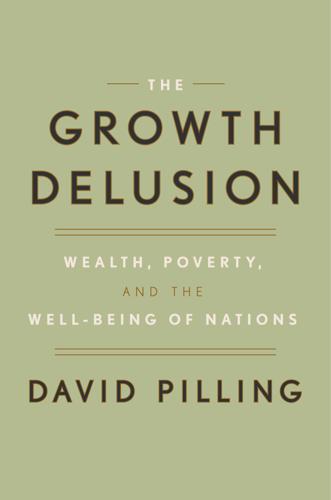
The Growth Delusion: Wealth, Poverty, and the Well-Being of Nations
by
David Pilling
Published 30 Jan 2018
Not only was it obvious how much money bankers were making—you only had to look at the cars they were driving to see that—but they also spent formidable amounts of money lobbying governments to make life yet easier for them. Banking became a bigger and bigger part of the US and UK economies. The “contribution” of the financial sector to national income grew enormously. In the 1950s, when banks were banks rather than “great vampire squids,” they contributed about 2 percent to the US economy.10 By 2008, that had quadrupled.11 Similar things happened in Britain. Until 1978 financial intermediation accounted for around 1.5 percent of whole economy profits. By 2008, that ratio had risen to about 15 percent. The perceived success of financial deregulation in generating economic dynamism encouraged other countries to do the same.
…
Kaupthing, the largest privatized bank, went on a binge of buying, merging and deal-making. It opened up an Internet bank, Kaupthing Edge, with branches in ten European countries, in a valiant effort to hoover up retail savings. Iceland had almost no track record in global finance, yet within a few years, according to one banker, Kaupthing began to think of itself as “the Goldman Sachs of the Arctic.”8 Then—and you probably guessed this was coming—it all went horribly wrong. And I mean horribly. When Lehman Brothers went bust in September 2008, trust in the entire global financial system vanished overnight. Banks stopped lending to each other, unsure whether their counterparties were good for the money or whether their balance sheets too were riddled with toxic assets.
…
Taxpayers injected hundreds of billions of dollars to bail out some of the biggest names in banking, including Citigroup and American International Group, the world’s biggest insurer. Merrill Lynch was folded into Bank of America, Washington Mutual was sold to JP Morgan, and Lehman Brothers—well, you remember Lehman Brothers. Even Goldman Sachs and Morgan Stanley, the last two independent investment banks left standing, had to agree to become bank holding companies, which subjected them to greater regulation. In October 2008 $700 billion of taxpayer money was pumped into the Troubled Asset Relief Program, but not before Congress had rejected it once, prompting the biggest points fall in the history of the Dow Jones Industrial Average.

The Age of Stagnation: Why Perpetual Growth Is Unattainable and the Global Economy Is in Peril
by
Satyajit Das
Published 9 Feb 2016
Dan Sparks (head of Goldman Sach's mortgage trading): “About?” Senator Levin: “If you have an adverse interest to your client, do you have the duty to disclose that to your client?” Dan Sparks: “The question about how the firm is positioned or our desk is positioned?” Senator Levin: “If you have an adverse interest to your client when you are selling something to them, do you have a responsibility to tell that client of your adverse interest?” Dan Sparks: “Mr. Chairman, I am just trying to understand what the ‘adverse interest’ means…”8 Rolling Stone magazine journalist Matt Taibbi called Goldman Sachs “a great vampire squid wrapped around the face of humanity, relentlessly jamming its blood funnel into anything that smells like money.”9 But the US investment bank was not alone.
…
Chairman, I am just trying to understand what the ‘adverse interest’ means…”8 Rolling Stone magazine journalist Matt Taibbi called Goldman Sachs “a great vampire squid wrapped around the face of humanity, relentlessly jamming its blood funnel into anything that smells like money.”9 But the US investment bank was not alone. In 2011, UK's biggest bank, HSBC, was fined for selling long-term investment bonds that might never pay out to customers as old as ninety-three. Towers Watson, a global consulting firm, found that fund managers were focused on short-term gains and insufficiently on improving investment returns. They ran funds for themselves and intermediaries, such as financial advisers, rather than for customers whose savings were being invested.
…
Reduced funding for military research, the cancellation of the Superconducting Super Collider project, and the scaling down of Bell Laboratories meant that a large number of scientists, some from Eastern Europe and China, drifted into finance. These POWs—physicists on Wall Street, a term coined by Goldman Sachs's Emanuel Derman—helped drive the trading of complex instruments, which were now an established part of the finance economy. These events and their influences were central to the continuation of postwar expansion. The period commencing in the 1990s became known as the Great Moderation, an era of strong economic growth, high production and employment, low inflation, reduced volatility in the business cycle, and self-adulation among politicians, central bankers, and academic economists.
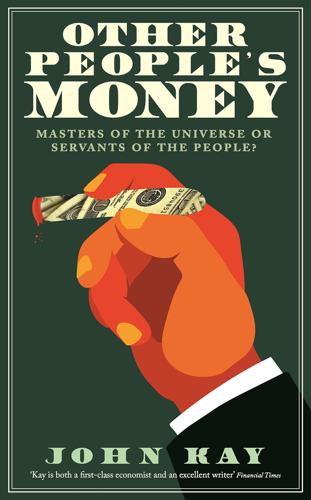
Other People's Money: Masters of the Universe or Servants of the People?
by
John Kay
Published 2 Sep 2015
Public opinion turned against banking and finance, reflected in the Occupy movement and the surge in popularity of fringe political movements. A century after Upton Sinclair and Ida Tarbell the tradition of the muckraker was revived. A new generation of journalists sought to expose corporate and – especially – financial malpractice. When the internet journalist Matt Taibbi described Goldman Sachs as ‘a giant vampire squid, sucking money from wherever it finds it’,45 the description quickly went viral. The firm, which did not even advertise its presence at 200 West Street, was pilloried in Congress and the press. The power of Taibbi’s metaphor comes from its implication that Goldman was not creating wealth itself but benefiting from wealth that had been created by other people and businesses.
…
These luckless investors would not have known, and nor would anyone else. ‘Putting the client first’ begins with identifying who the client is. In the case of Fabulous Fab’s transactions Goldman Sachs may have been acting for Paulson, who wanted to bet on widespread defaults in sub-prime mortgages. Or the firm may have been acting for the purchasers of the securities based on these mortgages. Goldman Sachs may have been trading for the benefit of the shareholders of Goldman Sachs. The business should properly have owed duties of loyalty and prudence towards whichever one of the three parties was its client, but could not properly have been acting for all three.
…
People I talk to in the financial world find it difficult to conceive of a future financial system in which large corporations are not active in the repo market, in which asset-backed securities are not integral to housing finance, and where there are no futures contracts or stock market indexes. Yet there was a time when none of these things existed, and there could be such a time again. We need some of the things that Citigroup and Goldman Sachs do, but we do not need Citigroup and Goldman Sachs to do them. And many of the things done by Citigroup and Goldman Sachs do not need to be done at all. In 2008 the established finance sector was on the point of collapse. Most of the major financial institutions of the world were dependent on government support for their continued existence – as, to a large extent, they still are.

Plutocrats: The Rise of the New Global Super-Rich and the Fall of Everyone Else
by
Chrystia Freeland
Published 11 Oct 2012
In his early twenties, Paulson worked at the Pentagon, and then in Richard Nixon’s White House. Throughout his thirty-year career at Goldman Sachs Paulson was renowned for his political savvy both inside the firm and far beyond its old headquarters at 85 Broad Street, deftly building an influential network of connections as far afield as China. He made his career in the relationship business of investment banking, and within Goldman Sachs, Paulson was known as an expert operator. “When he ran the Chicago office, he managed to get the entire firm to work for him,” one Goldman Sachs partner who had worked closely with Paulson told me admiringly. So how did this smart, experienced leader come to participate in such an ill-judged lunch, the sort of insider meeting that is the stuff of fantasy for the Goldman haters?
…
Thanks to Jones, Doriot, and Posner, being in the “hundreds of millions” circle isn’t enough. To understand how that sentiment has ratcheted up individual compensation for Wall Street’s salarymen—not just the entrepreneurs who take the risk of going it alone—consider this fact: in 2011, 42 percent of Goldman Sachs’s revenues were spent paying its employees, who earned an average of $367,057. Nor is that princely compensation restricted to the über-bankers at Goldman Sachs. At Morgan Stanley, which made a $4 billion mistake on the eve of the financial crisis and whose recovery from it has been lackluster, compensation accounted for 51 percent of revenue in 2010. At Barclays, which now owns Lehman, the figure was 34 percent; at Credit Suisse, it was 44 percent.
…
Two days before Bloomberg and Schumer took to the op-ed pages of the Wall Street Journal to raise the curtain on their report, another bipartisan pair, Glenn Hubbard, the dean of Columbia Business School, former Bush adviser, and future Mitt Romney adviser, and John Thornton, the active Democratic donor and former president of Goldman Sachs, announced that they, too, had organized a study on costly regulation and whether it was causing the U.S. capital markets to lose ground to foreign rivals. Hank Paulson, the Republican Treasury secretary and former chairman and CEO of Goldman Sachs, traveled to New York a few weeks after these twin editorials to give a speech to the Economic Club of New York on “The Competitiveness of U.S. Capital Markets” in which he praised the Bloomberg/Schumer op-ed as being “right on target.”
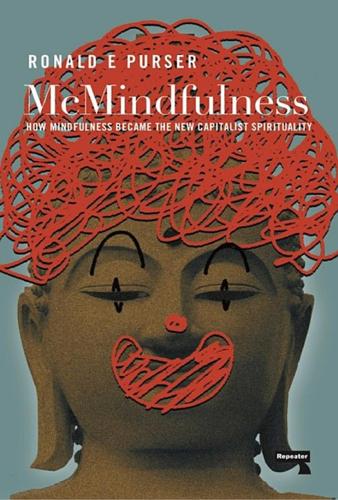
McMindfulness: How Mindfulness Became the New Capitalist Spirituality
by
Ronald Purser
Published 8 Jul 2019
“We are living through a major tipping point.”7 Getting down to business, fellow panelist William George — a senior fellow at the Harvard Business School who sits on several executive boards and once ran Medtronic — underlined the benefits. “The main business case for mindfulness is that if you’re more focused on the job, you’ll become a better leader,” he said. “Even Goldman Sachs is doing it.” It remains unclear how this has changed an investment bank once likened to “a great vampire squid wrapped around the face of humanity, relentlessly jamming its blood funnel into anything that smells like money.”8 George is a director of Goldman Sachs. A few years earlier, the Buddhist scholar and teacher David Loy challenged George’s advocacy of mindfulness to managers. Loy wrote an open letter, asking George if his meditative practice had any impact on corporate social responsibility, or his role in demanding it from fellow board members at Novartis, ExxonMobil and Goldman Sachs.9 Loy’s letter included a list of the unethical practices of these companies.
…
Loy wrote an open letter, asking George if his meditative practice had any impact on corporate social responsibility, or his role in demanding it from fellow board members at Novartis, ExxonMobil and Goldman Sachs.9 Loy’s letter included a list of the unethical practices of these companies. “I would like to learn how, in light of your meditation practice, you understand the relationship between one’s own personal transformation and the kind of economic and social transformation that appears to be necessary today, if we are to survive and thrive,” Loy wrote. George never replied, despite several follow-ups. His silence speaks louder than words.
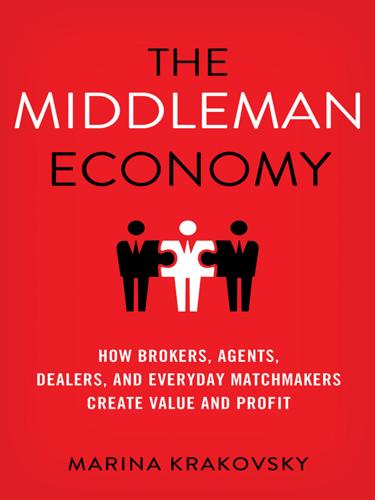
The Middleman Economy: How Brokers, Agents, Dealers, and Everyday Matchmakers Create Value and Profit
by
Marina Krakovsky
Published 14 Sep 2015
To my mind, nasty characterizations of middleman minorities as unwelcome guests feeding off their hosts further discredited the notion that middlemen are parasites.28 I am still convinced that the general stereotype of the parasitic middleman is wrong—as all stereotypes are—but the more reporting I did, the harder it was to deny that in many specific cases, individual middlemen or organized groups of them do act like free riders, causing more harm than good. That’s how many of us regard Goldman Sachs, the Wall Street giant that the journalist Matt Taibbi famously, and to great applause, called “a great vampire squid wrapped around the face of humanity, relentlessly jamming its blood funnel into anything that smells like money.”29 Indeed, a study of brand perceptions showed that people’s ratings of Goldman Sachs put the company squarely in the cold-incompetent quadrant.30 It’s not just Goldman Sachs that can evoke contempt, of course. Consider today’s typical money managers: whether they are personal financial advisors or pros managing multibillion-dollar mutual funds, most fail to beat the market—and when you take management fees into account, most actually underperform cheaper alternatives, such as index funds.31 What’s more, although there may be value to having an expert tailor a portfolio of investments right for your age and risk preferences, recent evidence suggests that financial advisors tend to create one-size-fits-all portfolios for their clients, providing off-the-rack services for bespoke-level fees.32 So when people say, as PBS economics correspondent Paul Solman has, that “most money management firms are parasites who live handsomely off innocent investors,” their strong feelings have a basis in reality.33 Consider, too, the primary middlemen in car sales in the United States: although many new-car dealers are probably skilled, honest, and customer-oriented, their trade groups are another story: the National Automobile Dealers Association and its state and local counterparts seem most concerned with lobbying for protectionist laws that benefit neither car buyers nor manufacturers.34 Middlemen who are seen as both cold (interested only in their own gain) and incompetent (creating more cost than value) will evoke contempt,35 and for them, the Parasite label is harsh but more or less apt.
…
Fixed Commissions and Social Waste in the Real Estate Industry,” Journal of Political Economy 111, no. 5 (2003): 1076–122. 2 THE CERTIFIER: APPLYING THE SEAL OF APPROVAL 1.American Pickers, Too Hot to Handle, season 2, episode 18, 2011. 2.Libby Callaway with Mike Wolfe, Frank Fritz, and Danielle Colby, American Pickers Guide to Picking (New York: Hyperion, 2011), 11. 3.Libby Callaway with Mike Wolfe, Frank Fritz, and Danielle Colby, American Pickers Guide to Picking, 107. 4.Loren Feldman, “Goldman Sachs and the $580 Million Black Hole,” New York Times, July 14, 2012. 5.Ruchika Tulshyan, “$100,000 Matchmaker, Make Me a Match,” Time, August 2, 2010. 6.This is the International Marriage Broker Regulation Act of 2005, also known as IMBRA. Government intervention was necessary because there wasn’t enough of a market incentive for these brokers to screen the men, who were the buyers in these transactions.
…
Robinson, 136–8 car buying, 164–72 see also Concierges CarLotz, 165–8, 170–2 Carlypso, 171–2 CBS Sports, 180 Certifiers buying direct and, 65–7 cost and, 70–2 examples, 47–50, 58–62 as expert, 54–8 explained, 7 as gatekeeper, 67–70 reputation and, 62–5 role, 47 scouting and, 51–4 skipping the middleman, 50–1 Charness, Gary, 87–8, 92, 94, 103 cheating, 13, 67, 73–4, 76, 82–3, 102–3, 192 Chegg, 66, 124, 130 Chopra, Sunil, 137–42 Clancy, Tom, 68–70 Close, Casey, 186 clusters, 24–7, 29 Coffman, Lucas, 180–2 Communications Decency Act of 1996, 91 competence, 9–13, 112 Concierges earning your fee, 158–61 example, 145–8 explained, 7 middle way and, 161–4 real estate and, 158–61 role, 145 scarcity/abundance and, 154–8 simplicity and, 164–72 travel and, 148–53 Condé Nast Traveler, 146 Confucius, 28 Consumer Connection, 55 contrarianism, 127, 132–3 Coverdill, James E., 175–6 Crabtree, Michael, 179–80 Craigslist, 30–5, 37, 44–6, 65, 89, 171 decision simplicity, 169 Dell, Michael, 195–7 Dictator Game, 181–2 Direct from Dell (Dell), 195 Disney, 140 Dropbox, 18–20 Eachnet, 85 eBay Certifiers and, 58–62, 134, 164 Concierges and, 169 Eachnet and, 85, 102 Enforcers and, 84–5, 91 feedback and, 84–5, 89, 134 middlemen and, 3–4, 7 reputation and, 62, 67, 91 Eberlijn, Nina, 148–51 Edmunds.com, 165 Einstein, Albert, 127 Elberse, Anita, 135 Enforcers clients and, 107–9 explained, 7 knowing the workers, 75–7 need for, 73–5 playing watchdog, 77–8 punishment and, 92–7 reputation and, 85–6 restaurant business and, 78–84 role, 73 setting shared standards, 101–7 threat of consequences and, 86–8 trading in private information, 97–100 weak vs. strong, 88–92 Enron, 41 Expedia, 145 experiments Dictator Game, 181–2 Investment Game, 86–8, 92–4, 101–5 “Letter E” experiment, 131 networking and, 21 reputation and, 62 Ultimatum Game, 183–4 watchdogs and, 77–8 external risk, 111, 120, 123, 125–8, 142 see also risk Facebook, 4, 20, 22–3, 36, 80, 128–9, 137, 175 farmers’ markets, 66 Feller, William, 142 Fernandez-Mateo, Isabel, 98–100 Fershtman, Chaim, 183–4 Finlay, William, 175–6 Fischbacher, Urs, 181 Flash Boys (Lewis), 112 Floodgate, 5, 124–5, 127, 132 Free (Anderson), 39 Friendster, 36 Galinsky, Adam, 131 gallerists see art gallerists Gambetta, Diego, 74 Game-Changer (McAdams), 90 Garden, Sara, 193–4 Gates, Bill, 3 General Electric, 8 Give and Take (Grant), 41 Gneezy, Uri, 183–4 Goldberg, Bryan, 179 Goldman, Eric, 91 Goldman Sachs, 10 Google, 21, 128, 156, 175 Gottlieb, Robert, 69–70 Graham, Paul, 125 Granovetter, Mark, 24, 27, 42 Grant, Adam, 41 Green, Michael, 177 Greylock, 125 Grosvenor, Deborah, 68–70 Groupon, 44 GrubHub, 38, 40 Hall, Sarah, 146 Harley-Davidson, 137 Hawkison, Paul, 53–4, 71 headhunters, 2, 7, 61, 66, 175–6, 180 see also Insulators Hewlett-Packard, 196 hidden action, 74, 104 hidden information, 66, 73–4 Hoffman, Reid, 27 HomeAway, 90–1 Horejs, Jason, 113–17, 135, 198 Houston, Drew, 18 Hunt for Red October, The (Clancy), 68 Insulators agents and, 178–80 black markets and, 174–5 duty and, 190–3 example, 173–4 explained, 7 need for, 193–4 niceness and, 185–90 recruiting and, 175–8, 180–2 role, 173 toughness and, 182–5 insurance Bridges and, 30–1 Concierges and, 172 Insulators and, 188 “Market for Lemons” and, 65 middlemen and, 2 Risk Bearers and, 111–14, 121–2, 138–9 internal risk, 123, 126 see also risk Investment Game, 86–8, 92, 94, 101–3, 105 iSoldIt, 3, 59 J.
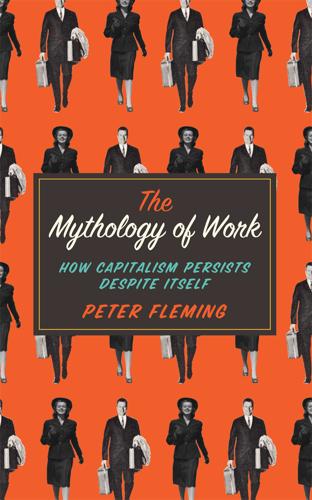
Mythology of Work: How Capitalism Persists Despite Itself
by
Peter Fleming
Published 14 Jun 2015
A contemporary version of Svejk-like behaviour in the workplace is provided by Carmen Segarra, the US Federal Reserve Bank of New York regulator who secretly taped 48 hours of conversation that revealed the intimate relationship between regulators and Goldman Sachs. The degree of implicit cooperation between the Fed watchdog and Goldman Sachs was so close that she decided to gain evidence in case she could no longer participate and was fired (which she eventually was). Goldman Sachs is a very powerful, very aggressive and very male institution. Following the financial crisis, Rolling Stone Magazine colourfully described the company as ‘a great vampire squid wrapped around the face of humanity, relentlessly jamming its blood funnel into anything that smells like money’.
…
But an institutional climate of fear was deeply ingrained, and large investment banks could count on the regulators turning a blind eye when required. As she recorded, Segarra was mostly invisible, a wallpaper character that looked like everybody else. She finally spoke out when a superior asked her to change her report about Goldman Sachs so that it omitted a damaging fact. Her defiance was no doubt licensed by the clandestine voice recorder, which was a stroke of genius. Coming out of the woodwork at the crucial time, and knowing full well that it would certainly mean ‘moving on’, is a definitive Svejkian trait. As Segarra refuses to change the damaging report, her boss Jonathan Kim suddenly concentrates on her, amplifying the ‘I, Job’ function.
…
Sinha Group ref1 Becker, G. ref1, ref2, ref3, ref4 Benjamin, W. ref1, ref2 Berardi, F. ref1 Beynon, H. ref1 big government ref1, ref2, ref3 Bikini Kill ref1 biopolitics and biopower ref1, ref2, ref3, ref4, ref5, ref6, ref7, ref8 and uses of illness at work ref1 Bloch, E. ref1 body clock ref1 bonuses ref1, ref2, ref3, ref4 Brabeck, Peter ref1 Branson, Richard ref1 Braverman, H. ref1 Brecht, B. ref1 Breed, L. ref1 British Journal of Psychiatry ref1 British Petroleum (BP), rebranded as ‘Beyond Petroleum’ ref1, ref2, ref3 Brown, Derren ref1 Bukowski, C. ref1, ref2, ref3, ref4 bullshit jobs ref1 bureaucracy ref1, ref2, ref3, ref4, ref5 Buried (Cortés) ref1 Bush, George W. ref1, ref2 business ethics ref1, ref2, ref3, ref4, ref5, ref6 see also corporate social responsibility capitalism ref1, ref2 and class ref1, ref2 and critical theory ref1 and debt ref1 and democracy ref1, ref2 effect on time ref1, ref2, ref3 and engagement of workers ref1, ref2 and freedom of expression ref1 global ref1, ref2, ref3, ref4, ref5 and ideological structures ref1 and rationalization ref1, ref2 shareholder capitalism ref1, ref2, ref3, ref4 and surplus labour ref1 see also neoliberal capitalism Carbon Pollution Reduction Scheme (Australia) ref1 Carr, Allen ref1 Cederström, C. ref1 Certeau, M. de ref1, ref2 Challenger Space Shuttle (1986) ref1 Chomsky, N. ref1 Cipollone, Mrs ref1 circadian rhythms ref1 Clastres, P. ref1 climate change denial ref1 co-optation ref1, ref2, ref3, ref4, ref5 the common ref1, ref2, ref3 communication guerrilla groups ref1 communism ref1, ref2, ref3 construction industry, house building ref1, ref2 consumer society ref1, ref2, ref3 corporate citizenship ref1, ref2, ref3 corporate ideology ref1 and contradiction ref1 and enlightened self-interest ref1 and ‘false truth-telling’ ref1, ref2, ref3 impact of financial crisis ref1 as lie telling ref1 corporate social responsibility (CSR) ref1, ref2, ref3, ref4 in tobacco industry ref1 corporations ref1 ‘creating shared value’ ref1, ref2 and development of capitalist ideology ref1 and work–life balance policies ref1 Cortés, Rodrigo ref1 Crane, A. ref1 Crary, J. ref1, ref2 creditocracy ref1 Critchley, S. ref1 criticism/criticality and ‘sad truths’ ref1 usefulness of ref1 Crozier, M. ref1 The Cube (Natali) ref1 culture management ref1 Daimler ref1 Dardot, P. ref1, ref2 Dawkins, Richard ref1 deaths work-related ref1, ref2 see also suicides debt/indebtedness ref1, ref2, ref3, ref4, ref5, ref6 deformalization ref1 informality and authoritarianism ref1, ref2 Deleuze, G. ref1, ref2, ref3, ref4 biopower ref1, ref2, ref3 on criticism/criticality ref1, ref2 and de-subjectification ref1 and deceptive truths ref1 and illness ref1, ref2, ref3 language ref1, ref2 societies of control ref1, ref2, ref3, ref4, ref5, ref6, ref7, ref8, ref9 democracy and capitalism ref1, ref2 corporations and ref1, ref2 and false truth telling ref1 post-state democratic organizations ref1 self-organized ref1 workplace ref1 desertion ref1, ref2, ref3, ref4, ref5 dialogical reason autobiographical truth telling ref1 critique of ref1 dialectical reason ref1, ref2 dialogical politics at work ref1 dissenting consent ref1 humour ref1 irony ref1, ref2 post-dialogical politics at work ref1 abandonment ref1 absentification ref1 disciplinary power ref1, ref2, ref3, ref4 disposability ref1, ref2, ref3 see also abandonment ideology dissent commodification of ref1 dissenting consent ref1 Edwards, R. ref1 Eggers, D. ref1 email ref1, ref2, ref3, ref4 using outside working hours ref1, ref2, ref3, ref4, ref5 empty labour ref1, ref2 ‘Endies’ (Employed but with No Disposable Income or Savings) ref1 Enron ref1 Erhardt, Moritz ref1 escape ref1, ref2, ref3, ref4, ref5 antinomies of ref1 cinematic visions of ref1, ref2, ref3 negative optics of revolt ref1 see also alcohol consumption; desertion; post-labour strategy; suicide; totality refusal EU Time Directive ref1 exploitation ref1, ref2, ref3, ref4, ref5, ref6 CSR and ref1, ref2, ref3, ref4 and debt ref1, ref2 and escape ref1, ref2 and managerialism ref1, ref2 self-exploitation ref1, ref2, ref3 and self-reliance ref1, ref2, ref3 and subsidization ref1 see also working hours false truth telling ref1 semantic structure of ref1 in tobacco industry ref1, ref2 using the truth to lie ref1 see also dialogical politics; rituals of truth and reconciliation Feldman, R.S. ref1 financial crisis (2008) ref1, ref2, ref3, ref4, ref5, ref6, ref7 impact on corporate ideology ref1 Fisher, M. ref1 Flanagan, B. ref1, ref2, ref3, ref4, ref5 Fleming, P. ref1 flexible labour ref1, ref2, ref3, ref4, ref5 collective self-reliance of workforce ref1, ref2, ref3 Fordism ref1, ref2, ref3, ref4, ref5 and alienation ref1 end of ref1, ref2, ref3, ref4, ref5 Foster, J.B. ref1 Foucault, M. ref1, ref2 aphasia ref1 biopower and biopolitics ref1, ref2, ref3 disciplinary power ref1 parrhesia ref1, ref2, ref3 prison ref1 and regimes of truth ref1 technologies of the self ref1 Foxconn (China) ref1 France Telecom ref1 free time, dangers of ref1, ref2 Freud, S. ref1, ref2, ref3 Friedman, L. ref1 Friedman, M. ref1 ‘Fuck you!’ capitalism ref1, ref2, ref3, ref4 General Motors plant (Michigan) ref1 Goffee, R. ref1 Goldman Sachs ref1 The Good Soldier Svejk (Hasek) ref1 Gordon, D. ref1 Gorz, A. ref1, ref2 Graeber, D. ref1 Groundhog Day (Ramis) ref1 Guattari, F. ref1, ref2, ref3 on criticism/criticality ref1 and de-subjectification ref1 language ref1, ref2 Gujarat NRE ref1 Gulf of Mexico oil spill (2010) ref1 Hamper, B. ref1 Hanlon, G. ref1 Hardt, M. ref1 Hart, A. ref1 Harvard Business Review (HBR) ref1 Harvey, D. ref1, ref2 Hayek, F. ref1, ref2, ref3 health and safety ref1, ref2 ‘Help to Buy’ support scheme ref1 Hirschhorn, N. ref1 Hodgkinson, T. ref1 holiday policy ref1 Houellebecq, Michel ref1, ref2, ref3 human capital ref1, ref2, ref3, ref4, ref5, ref6, ref7 human relations movement ref1 Human Resource Management (HRM) ref1, ref2, ref3, ref4, ref5, ref6 humour ref1 ‘I, Job’ function ref1, ref2, ref3, ref4, ref5, ref6 and biopower ref1, ref2 and death drive ref1, ref2 as escape into work ref1 and illness ref1, ref2, ref3 resisting ref1, ref2, ref3, ref4, ref5, ref6 see also escape; totality refusal see also work, as all-encompassing; working hours illegal immigrants, deportations ref1 illness ref1, ref2 collective ref1, ref2 see also Social Patients’ Collective as desirable experience ref1, ref2, ref3, ref4 of managers ref1, ref2 and productive power ref1, ref2 as weapon against capitalism ref1 ‘immersion room’ exercise ref1, ref2, ref3, ref4 imperceptibility ref1 see also invisibility incentivization ref1 indexation process ref1, ref2, ref3, ref4, ref5 informality and authoritarianism ref1, ref2 see also deformalization insecurity ref1 Institute of Leadership and Management (ILM) ref1, ref2, ref3 invisibility ref1, ref2 ‘Invisible Committee’ ref1, ref2 Italian autonomist thought ref1, ref2 Jameson, F. ref1 Jones, G. ref1 Junjie, Li ref1 Kamp, A. ref1 Kein Mensch ist illegal ref1 Kellaway, L. ref1 Key Performance Indicators (KPIs) ref1 Keynes, J.M. ref1, ref2 Khrushchev, Nikita ref1, ref2 Kim, Jonathan ref1 King, Stephen ref1 ‘Kitchen Debate’ ref1 Kramer, M. ref1, ref2 labour unions ref1 dissolution of ref1, ref2 language, evolution of ref1 Larkin, P. ref1 Latour, B. ref1, ref2 Laval, C. ref1, ref2 Lazzarato, M. ref1, ref2 leaders backgrounds ref1 remuneration and bonuses ref1, ref2, ref3, ref4, ref5 see also managers Lefebvre, H. ref1 Leidner, R. ref1 Lewin, D. ref1 liberation management ref1, ref2, ref3, ref4, ref5 life itself, enlisting ref1, ref2, ref3, ref4, ref5 lines of flight ref1, ref2 Lordon, F. ref1, ref2, ref3 Lucas, R. ref1, ref2 Lukács, G. ref1 Lynch, R. ref1 McChesney, R. ref1 McGregor, D. ref1 management ref1, ref2 and class function ref1, ref2 as co-ordination ref1 and inducement of willing obedience ref1, ref2 information deficit ref1 and power ref1, ref2 self-justification rituals ref1 as transferable skill ref1, ref2 managerialism ref1, ref2, ref3, ref4, ref5, ref6, ref7 and abandonment ideology ref1, ref2, ref3, ref4, ref5 and boundary management ref1 and conflict-seeking behaviour ref1 division between managers and managed ref1, ref2 general principles of ref1 and leadership ref1 profligate management function ref1 refusing ref1 and securitization ref1 as self-referential abstraction ref1 managers as abandonment enablers ref1, ref2 and deformalization ref1 and engagement of workers ref1, ref2 lack of practical experience ref1 overwork ref1, ref2 see also leaders Marcuse, H. ref1 Market Basket supermarket chain ref1 Marx, K. ref1, ref2, ref3, ref4, ref5, ref6 Maslow, A. ref1 Matten, D. ref1 meat consumption ref1 Meek, J. ref1 Meyerson, D. ref1 Michelli, J. ref1 Miller, W.I. ref1 Mitchell, David ref1 mobile technology ref1, ref2, ref3, ref4, ref5, ref6, ref7 Modafinil ref1, ref2 Monaghan, A. ref1 money ref1, ref2 see also accumulation Mooney, G. ref1 Moore, A.E. ref1 Moore, Michael ref1, ref2 music industry ref1 Naidoo, Kumi ref1 NASA ref1 Natali, Vincenzo ref1 Negri, A. ref1, ref2 neoliberal capitalism ref1, ref2, ref3, ref4, ref5, ref6, ref7 and bureaucracy ref1 and ideal worker ref1, ref2 and non-work time ref1, ref2 and paranoia ref1, ref2 resisting ref1, ref2 see also post-labour strategy and threat of abandonment ref1, ref2 and truth telling ref1, ref2, ref3 neoliberalism ref1, ref2, ref3, ref4, ref5, ref6 and class relations ref1, ref2, ref3 and disciplinary power ref1 and human-capital theory ref1 and impossibility ref1, ref2, ref3, ref4, ref5, ref6 and micro-fascism ref1 and reign of technocrats ref1 role of state ref1 and truth telling ref1, ref2 and worker engagement ref1, ref2, ref3 Nestlé ref1 New Public Management ref1, ref2 New Zealand, and capitalist deregulation ref1 New Zealand Oil and Gas (NZOG) ref1 Newman, Maurice ref1 Nietzsche, Friedrich ref1, ref2 Nixon, Richard ref1, ref2 Nyhan, B. ref1 obsession ref1, ref2, ref3, ref4, ref5, ref6, ref7, ref8 Onionhead program ref1 overcoding ref1, ref2, ref3, ref4, ref5, ref6, ref7 The Pain Journal (Flanagan) ref1, ref2, ref3 paranoia ref1, ref2, ref3, ref4 overwork/paranoia complex ref1, ref2 Paris Commune ref1, ref2 Parkinson’s Law ref1 Parnet, C. ref1 Parsons, T. ref1 Peep Show (TV comedy) ref1 pensions ref1, ref2 personnel management ref1 see also Human Resource Management Peters, T. ref1 Philip Morris ref1 Pike River Coal mine (New Zealand) ref1 Pollack, Sydney ref1 Pook, L. ref1 Porter, M. ref1, ref2 post-labour strategy, recommendations ref1 postmodernism ref1, ref2, ref3 power ref1, ref2, ref3, ref4, ref5 and truth telling ref1 Prasad, M. ref1 Price, S. ref1 private companies, transferring to public hands ref1 privatization ref1, ref2, ref3, ref4, ref5, ref6, ref7 profit maximization ref1, ref2, ref3, ref4, ref5 quantitative easing ref1 Rand, Ayn ref1 rationalization ref1, ref2, ref3 Reifler, J. ref1 reserve army of the unemployed ref1 Ressler, C. ref1 results-only work environment (ROWE) ref1, ref2, ref3 Rimbaud, A. ref1 Rio+20 Earth Summit (2012) ref1 ‘riot grrrl’ bands ref1 rituals of truth and reconciliation ref1 Roberts, J. ref1 Roger Award ref1 Roger and Me (Moore) ref1 Rosenblatt, R. ref1 Ross, A. ref1, ref2 Ross, K. ref1 Rudd, Kevin ref1 ruling class fear of work-free world ref1, ref2 and paranoia ref1, ref2 Sade, Marquis de ref1 Sallaz, J. ref1 Saurashtra Fuels ref1 Scarry, E. ref1 Securicor (G4S) ref1 Segarra, Carmen ref1 self-abnegation ref1 self-employment ref1 self-management ref1, ref2, ref3, ref4, ref5 self-preservation ref1, ref2, ref3, ref4 self-sufficiency ref1, ref2, ref3 shareholder capitalism ref1, ref2, ref3, ref4 shift work ref1, ref2 see also working hours Shragai, N. ref1 sleep and circadian rhythms ref1 as form of resistance ref1 working in ref1, ref2, ref3 smart drugs ref1, ref2 Smith, Roger ref1 smoking and addiction ref1 dangers of ref1, ref2 scientific research ref1 sociability ref1, ref2 ‘the social’ ref1, ref2 social factory ref1, ref2, ref3, ref4, ref5, ref6, ref7 and structure of work ref1 social media ref1 Social Mobility and Child Poverty Commission ref1 Social Patients’ Collective (SPK) ref1, ref2, ref3 social surplus (commons) ref1, ref2, ref3 socialism ref1, ref2, ref3, ref4 Sontag, S. ref1 Spicer, A. ref1 stakeholder management ref1, ref2 Starbucks ref1 state, theory of ref1 subcontracting ref1, ref2, ref3 subsidization ref1, ref2, ref3, ref4, ref5, ref6, ref7 suicide as act of refusal ref1 Freud’s definition ref1 work-related ref1, ref2, ref3, ref4, ref5 surplus labour ref1, ref2 surplus living wage ref1 ‘tagged’ employees ref1 ‘tagged’ prisoner ref1 Tally, Richard ref1 taxation ref1, ref2, ref3 Taylor, F.W. ref1 Taylor, S. ref1 Taylorism ref1 technological progress, and emancipation from labour ref1 Thatcher, Margaret ref1 Thatcherism ref1 They Shoot Horses Don’t They?
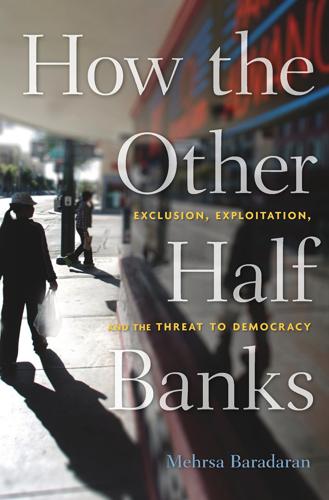
How the Other Half Banks: Exclusion, Exploitation, and the Threat to Democracy
by
Mehrsa Baradaran
Published 5 Oct 2015
All you capitalists that want to show up to Lake Michigan, I’m going to start organizing.… I’ll tell you what, if you read our Founding Fathers, people like Benjamin Franklin and Jefferson, what we’re doing in this country now is making them roll over in their graves.28 Plenty of scorn was also directed at the modern moneylenders. Journalist Matt Taibbi called Goldman Sachs “a great vampire squid wrapped around the face of humanity, relentlessly jamming its blood funnel into anything that smells like money.” The Occupy Wall Street movement embodied this disdain for reckless moneylending with demands that bankers be sent to jail. Their signs could have been written by a modern-day Nehemiah or Andrew Jackson: “Tax Wall Street Leeches,” “Turn Wall Street into Tahrir Square,” “JP Morgan is a Kleptomaniac,” “Jail the Bankers,” “Tear Down this Wall Street,” “Jesus was the 99%,” and “Kick ‘M in the Junk Bonds.”29 (Timothy Geithner dismissed those who were uncomfortable with bailing out banks as demanding “Old Testament Justice,”30 which seems accurate given the admonitions against usury in the book, but the modern state is no longer persuaded by Nehemiah’s arguments.)
…
The regulators knew of the situation, but because of the culture of the firms, they did not feel comfortable raising issues about the firms without their superiors’ blessings.128 Senior regulators even admitted to having witnessed “the capture set in.”129 This culture resulted in inaction in the face of mounting risks. In September 2014, a former employee of the FRBNY who was one of Goldman Sachs’ designated regulators released secret recordings of her time regulating the large firm. The tapes revealed what most banking experts suspected for years—Goldman Sachs, not its regulator, called the shots. The FRBNY regulators stationed at Goldman Sachs, many of whom would end up working at the investment bank, cowered at meetings with bankers where it should have been their role to press. When former employee Carmen Segarra did push, she was fired for having “sharp elbows” and “breaking eggs.”
…
This “revolving door” effect creates an environment where bank supervisors and bankers are often the same people. Henry Paulson, for example, the secretary of the Treasury who orchestrated the Troubled Asset Relief Program (TARP), was a former Goldman Sachs CEO, as was his predecessor in the Clinton Treasury, Robert Rubin. “In short,” observes one commentator, “Paulson, CEO of Goldman Sachs, was pushing free money to his former colleagues.”25 It is hard to imagine a scenario in which Paulson would let Wall Street fail, even if the sector’s economic contribution at the time was proven to be less than that of piano-playing cats.
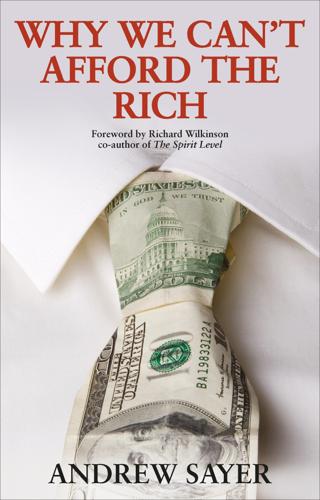
Why We Can't Afford the Rich
by
Andrew Sayer
Published 6 Nov 2014
Hudson describes it as ‘a scientific sounding euphemism for bank lobbyists’.106 In effect, the technocrats protected the rule of the rich from the threat of democratic reaction. Goldman Sachs’ European reach In a famous article on Goldman Sachs in Rolling Stone, Matt Taibbi wrote: ‘The world’s most powerful investment bank is a great vampire squid wrapped around the face of humanity, relentlessly jamming its blood funnel into anything that smells like money.’107 It also ensured that it was represented far and wide in politics. In the US, Goldman Sachs men Robert Rubin and Hank Paulson both served periods of office as Treasury Secretary.108 But it has also had extensive influence in Europe.
…
Belgian Karel van Miert, former EU Competition Commissioner, was an advisor to Goldman Sachs. So was Otmar Issing, former board member of Germany’s Bundesbank, economic advisor to Angela Merkel, and one of the creators of the euro.109 Antonio Borges, former head of the International Monetary Fund’s European division, was previously vice-chairman of Goldman Sachs International. Since 1985, three European commissioners for competition have been Goldman Sachs men. In the UK, Lord Griffiths is another international advisor to Goldman Sachs, and Vice-Chairman of Goldman Sachs International. He is a director of Times International Holdings Limited, former professor at the London School of Economics, former Dean at City University Business School, and was a director of the Bank of England from 1983 to 1985.
…
Hiding this debt was crucial for Greece’s being allowed to join the euro in 2001, and for this Goldman Sachs got $300 million. It was assisted by the head of the Greek central bank, Luke Papademos, who was later appointed Prime Minister. On the Greek side, another former Goldman Sachs employee, Petros Christodoulou, Head of Greece’s debt management agency, was also alleged to be involved. Peter Sutherland, Attorney General of Ireland in the 1980s and another former EU Competition Commissioner, is now non-executive chairman of Goldman Sachs’s UK-based broker-dealer arm, Goldman Sachs International; until its collapse and nationalisation he was also a non-executive director of RBS.
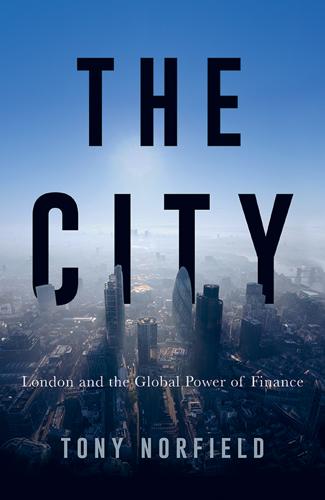
The City
by
Tony Norfield
Such policies have produced only mediocre results at best, and still leave hundreds of millions of people’s lives destroyed. This evokes Lenin’s description of imperialism as ‘moribund capitalism’. The financial system is an expression of contemporary imperialism shot through with many contradictions. 7. The Imperial Web In 2009, Rolling Stone magazine’s Matt Taibbi described Goldman Sachs, the US investment bank, as a ‘great vampire squid wrapped around the face of humanity, relentlessly jamming its blood funnel into anything that smells like money’.1 The striking image was detailed with examples of Goldman’s relationship to the US economy, although Taibbi also noted that its many alumni had secured powerful jobs in government or central banks worldwide to help it feed off ‘blood’, or value created, all over the world.
…
Table 5.1 Corporate control by controlling company, 2007 Rank Company name Country Cumulative % network control 1 Barclays PLC GB 4.1 2 Capital Group Companies Inc US 6.7 3 FMR Corp US 8.9 4 Axa FR 11.2 5 State Street Corp US 13.0 6 JP Morgan Chase & Co US 14.6 7 Legal & General Group PLC GB 16.0 8 Vanguard Group Inc US 17.3 9 UBS AG CH 18.5 10 Merrill Lynch & Co US 19.5 11 Wellington Management Co LLP US 20.3 12 Deutsche Bank AG DE 21.2 13 Franklin Resources Inc US 22.0 14 Credit Suisse Group CH 22.8 15 Walton Enterprises LLC US 23.6 16 Bank of New York Mellon Corp US 24.3 17 Natixis FR 25.0 18 Goldman Sachs Group Inc US 25.6 19 T Rowe Price Group Inc US 26.3 20 Legg Mason Inc US 26.9 21 Morgan Stanley US 27.6 22 Mitsubishi UFJ Financial Group Inc JP 28.2 23 Northern Trust Corp US 28.7 24 Société Générale FR 29.3 25 Bank of America Corp US 29.8 26 Lloyds TSB Group PLC GB 30.3 27 Invesco PLC GB 30.8 Note: Countries are indicated by a two-letter ISO code (CH is Switzerland, DE is Germany).
…
It provides an alternative source of funds for countries not favoured by the World Bank and the IMF and, more recently, it has played a key role in setting up a ‘New Development Bank’ (NDB), with Brazil, Russia, India and South Africa, in July 2014. This grouping of countries was prompted as much by the publicity arising from an article published in 2001, by an analyst from Goldman Sachs, as by their economic or political ties. He predicted that Brazil, Russia, India and China (South Africa, ‘S’, was added later to make BRICS) would likely play such a big role in the future world economy that they should be added to the structures of global decision-making, rather than being sidelined as unimportant countries compared to the established G7.

The Black Box Society: The Secret Algorithms That Control Money and Information
by
Frank Pasquale
Published 17 Nov 2014
But in this harsh new economic reality, the money “earned” by the speculators has all the more purchasing power, arrayed against the smaller incomes of those who did not take advantage of the bubble.170 Thus the great paradox of contemporary finance: its premier practitioners are far better at creating need and demand for their “product” (price discovery) than they are at actually providing it. Their primary results are murk, darkness, volatility, and doubt. Matt Taibbi called Goldman Sachs a “vampire squid;” an ink-squirting octopus of obfuscation would be fitting, too.171 Theoretical justifications for finance’s power focus on “free markets” generating fundamental knowledge about the economy. Without the great brokerages, and “bank holding companies,” how would we price debt, equity, or the more exotic risks assimilated into derivatives?
…
Cora Currier, “13 Reasons Goldman’s Quitting Exec May Have a Point,” ProPublica, March 14, 2012, http:// www.propublica.org /article /13-reasons-goldmans-quitting -exec-may-have -a -point. Shahien Nasiripour, “Goldman Sachs Values Assets Low, Sells High to Customers as Senate Panel Alleges Double Dealing,” Huffington Post, April 14, 2011, http://www.huffi ngtonpost.com /2011/04 /14 /goldman-sachs-values-asse _n _849398.html. 99. Kayla Tausche, “Wall Street into Snapchat, and Regulators Are on Alert,” CNBC, July 30, 2013, http://www.cnbc.com /id /100924846. 100. For example, since a “simple fi xed/floating interest-rate swap contract . . . has zero value at the start,” it “is considered neither an asset nor a liability, but is an ‘off-balance-sheet’ item.”
…
The most visible and controversial example so far has been the cooperation in Manhattan between the Department of Homeland Security, the New York Police Department, and several major banks.142 By 2009, the Lower Manhattan Security Coordination Center (LMSCC) was processing feeds from thousands of cameras run by Wall Street firms and the NYPD. One source identified Goldman Sachs, Citigroup, the Federal Reserve, and the New York 44 THE BLACK BOX SOCIETY Stock Exchange as participants at the center. The exact composition of the staff is a closely guarded secret, but there are likely many other Wall Street firms with “on-site representatives.”143 In the abstract, a post-9/11 partnership of this sort might seem like an efficient use of resources.
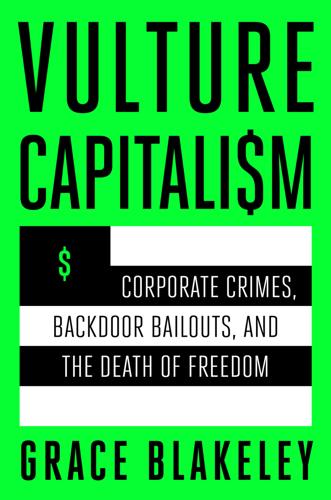
Vulture Capitalism: Corporate Crimes, Backdoor Bailouts, and the Death of Freedom
by
Grace Blakeley
Published 11 Mar 2024
In fact, research has shown that “individual banking executives with connections to the US Treasury made unusually large gains during and after the 2008 Troubled Asset Relief Program.”76 In other words, the policy choices made by governments after the financial crisis “ended up pushing power and wealth upward.”77 Some see this as more evidence for racialized conspiracy theories. As one columnist for the Jewish Chronicle noted in 2009, Rolling Stone’s description of Goldman Sachs as a “vampire squid” was “not without its problems for a bank with distinctly Jewish origins.”78 But the Chronicle went on to note that “the Rolling Stone writer does have a point.” The point is not that a secret cabal of bankers runs the world; it is that the largest and most powerful institutions are protected from the consequences of their actions in a way ordinary people are not.
…
Within a few months of the collapse of Lehman Brothers, the firm’s credit rating had been downgraded and it found itself on the brink of bankruptcy. AIG owed billions in insurance payments to some of the largest investment banks in the world, including Goldman Sachs, to whom the insurer owed at least $20 billion.42 AIG’s liabilities to Goldman were particularly significant because the bank had been selling its clients dodgy mortgage-backed securities before taking out insurance against the risk that the value of these securities would fall. Goldman Sachs had effectively made a massive bet against the US mortgage market with its clients as counterparties. Its actions were, as one journalist put it, “tantamount to building a house, planting a bomb in it, selling it to an unsuspecting buyer, and buying $20bn worth of life insurance on the homeowner—who you know is going to die!”
…
If AIG had gone down, the law stated that other policyholders would be protected.44 AIG wasn’t bailed out to protect ordinary policyholders; it was bailed out to save Goldman Sachs. The Fed gave AIG a loan worth $85 billion in exchange for 80 percent of the company’s equity, making it one of the largest bailouts in US history.45 The former chairman and CEO of Goldman, Henry Paulson, was central to the decision to grant the bailout. In fact, during the crisis, “Goldman Sachs had at least four dozen former employees, lobbyists or advisers operating in the highest reaches of power both in Washington and around the world.”
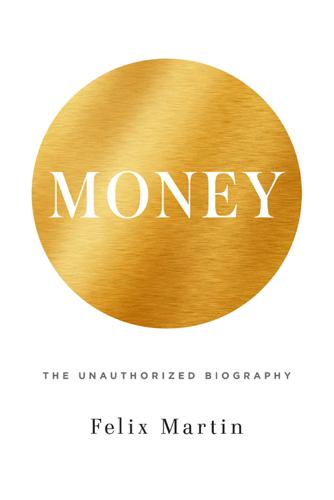
Money: The Unauthorized Biography
by
Felix Martin
Published 5 Jun 2013
ISBN 978-0-307-96243-0 (hardcover) ISBN 978-0-307-96244-7 (eBook) Jacket design by Evan Gaffney v3.1 To Kristina Contents Cover Title Page Copyright Dedication 1 What Is Money? 2 Getting Money’s Measure 3 The Aegean Invention of Economic Value 4 The Monetary Maquis 5 The Birth of the Money Interest 6 The Natural History of the Vampire Squid 7 The Great Monetary Settlement 8 The Economic Consequences of Mr. Locke 9 Money Through the Looking-Glass 10 Strategies of the Sceptics 11 Structural Solutions 12 Hamlet Without the Prince: How Economics Forgot Money … 13 … and Why It Is a Problem 14 How to Turn the Locusts into Bees 15 The Boldest Measures Are the Safest 16 Taking Money Seriously Notes Bibliography Acknowledgements Illustration Credits A Note About the Author 1 What Is Money?
…
Its practices may not have enjoyed the nice theoretical apparatus of Oresme—but then the merchants did not need scholastic logic to justify their activities. They were busily rediscovering an invention that would turn monetary society on its head in a way in which Oresme’s brilliantly argued tract never could. That invention was the bank. 6 The Natural History of the Vampire Squid THE MYSTERIOUS MERCHANT OF LYONS In around 1555 there arose a scandal in the city of Lyons.1 An Italian merchant had settled there and proceeded to make himself prodigiously rich in a remarkably short space of time. By itself, there was nothing particularly surprising about that. Lyons was one of the great commercial cities of France, and of Europe.
…
Rolnick, Velde, and Weber, 1996, 797. 21. Ibid. 22. Ibid. 23. Sumption, 2001, p. 195. 24. Johnson, 1956. 25. Ibid., p. 10. 26. Ibid., pp. 19–20. 27. Ibid., p. 38. 28. Ibid., p. 40. 29. Ibid., p. 6. 30. Ibid., p. 17. 31. Ibid., p. 44. 32. Ibid., p. 42. 6 The Natural History of the Vampire Squid 1. Described in Frankel, 1977, p. 15. 2. Élie Brackenhofer was told in 1634 that the Fair of Lyons had been founded in AD 172. See Braudel, 1992. 3. See Spufford, 2002, p. 19 ff. 4. Braudel, 1992, p. 91. 5. The phrase is Braudel’s, quoted in Frankel, 1977, p. 15. 6. Amis, 1984, pp. 119–20. 7.
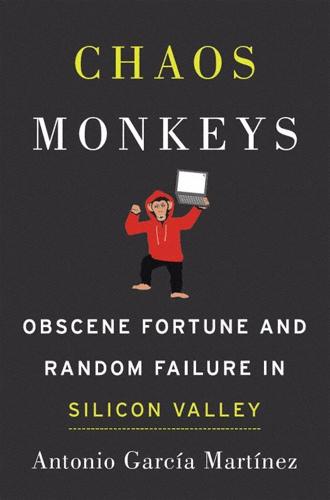
Chaos Monkeys: Obscene Fortune and Random Failure in Silicon Valley
by
Antonio Garcia Martinez
Published 27 Jun 2016
What else could I pimp out for page views? What other meme was flitting across the national zeitgeist? Oh! Who else but my former employer, that vampire squid with its tentacles violating virgins and robbing starving babies across the land? The great capitalist evil: Goldman Sachs. Everyone would cheer on its lynching. Imagine the lurid interest in what life was really like inside, plus the joy at its roasting. It would be a titillating spectacle of taboo revelation. New York tech and life at Goldman Sachs, those would be our first two forays into the corporate-driven, mercenary written word—“content marketing,” to use the hideous marketer’s term for it.
…
One of the few things I took from my sordid grad student pad was a copy of Michael Lewis’s Liar’s Poker, that classic of the Wall Street trading genre, for reference. My job on arrival? I was a pricing quant on the Goldman Sachs corporate credit trading desk.* That means I was responsible for modeling and pricing the various credit derivatives that the biggest credit-trading house in the world traded. We’ll get into what a derivative is in a moment. More important at Goldman Sachs than the “what” was the “who.” Goldman Sachs was unusual among Wall Street banks in that it had mostly kept a partnership management structure. Hence, every incoming employee was hired by a specific partner, and you were that partner’s boy.
…
Like a rock-bottom alcoholic contemplating his vomit-stained sheets through the haze of another postbender hangover, you occasionally asked yourself: How did I get here? How could I do this to myself? Where was the humanity? I joined Goldman Sachs after five flailing years in a physics PhD program at Berkeley. At the time, my graduate stipend (taxable as income!) was the princely sum of $19,000. The average salary at Goldman Sachs in 2005 was $521,000, and that’s counting each and every trader, salesperson, investment banker, secretary, mail boy, shoe shiner, and window cleaner on the payroll. One of the few things I took from my sordid grad student pad was a copy of Michael Lewis’s Liar’s Poker, that classic of the Wall Street trading genre, for reference.
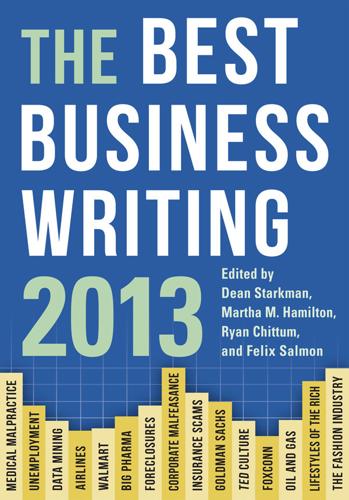
The Best Business Writing 2013
by
Dean Starkman
Published 1 Jan 2013
The vast majority of those denials, Wyatt says, were not legitimate. Goldman Sachs’s emphasis on maximizing profits rather than preventing foreclosures is typical of the servicing industry, he says, particularly the larger banks. “They could have addressed the crisis way earlier. Had companies changed their philosophy and said, ‘You know what? We’re not going to beef up our collections staff; we’re going to beef up our loss-mitigation staff.’ Had they done that and come up with loan-modification scenarios that were reasonable and put people into more affordable payments early on, we wouldn’t be where we are now.” A spokesman for Goldman Sachs said the company disagreed with Wyatt’s account but offered no specifics.
…
There’s a lot of people like me out there. How many of you are there? What are you willing to work for? Pamila Payne Los Angeles, CA 90068 Greg Smith 22. Why I Am Leaving Goldman Sachs New York Times The op-ed of the year, by a large margin, came from a formerly unknown South African equity-derivatives banker in London. In a self-serving but extremely powerful and resonant statement, he took on Goldman Sachs from the pages of the New York Times and won a book deal and a news cycle or three in the process. Greg Smith’s criticisms weren’t new, but this was the first time they’d come from inside rather than outside the company, giving them unprecedented and undeniable heft.
…
For most of the rest of the year, Goldman found itself on the back foot, defending itself from the impression the op-ed created. Today is my last day at Goldman Sachs. After almost twelve years at the firm—first as a summer intern while at Stanford, then in New York for ten years, and now in London—I believe I have worked here long enough to understand the trajectory of its culture, its people, and its identity. And I can honestly say that the environment now is as toxic and destructive as I have ever seen it. To put the problem in the simplest terms, the interests of the client continue to be sidelined in the way the firm operates and thinks about making money. Goldman Sachs is one of the world’s largest and most important investment banks, and it is too integral to global finance to continue to act this way.
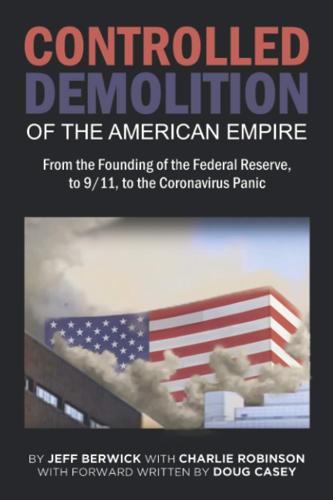
The Controlled Demolition of the American Empire
by
Jeff Berwick
and
Charlie Robinson
Published 14 Apr 2020
Instead, their application was approved, in large part because of the financial shimshamery of the Vampire Squid, and Greece was set on a course of self- destruction caused by feeding on the endless amount of cheap debt that is offered to members of the EU. Knowing damn well that Greece could never pay their original debt back, let alone the additional amount that they took on during their decade of debauchery, Goldman Sachs made sure to keep an eye on Greece so that they could sneak back in when things blew up, which they did, and help to orchestrate the fire sale that would most certainly be taking place, especially if they had any say in the matter.
…
Steve Mnuchin was appointed to head the Treasury, which was a good thing because he certainly does love money. He had a net worth of $385 million after a spotless career in some of the shadiest industries in the world: film producer, hedge fund manager, and as the Chief Information Officer at Goldman Sachs. His job was to steal money for Goldman Sachs through his computer programs that would front-run the market, making losing money an impossibility. Commerce Secretary, Wilbur Ross, founder of WL Ross & Co., had a net worth of $2.5 billion and was implicated in the theft of $120 million of other people’s money while running his firm, a firm that has been fined by the Securities and Exchange Commission for millions of dollars.188 He also ran the bankruptcy- restructuring advisory practice for the Rothschilds for many years while at N M Rothschild & Sons, where he met Donald Trump while advising him on one of his many bankruptcies.
…
Greece is the test case for how austerity currently operates, and what America can expect once the global banking syndicate gets done with them. Goldman Sachs was the bank behind Greece’s austerity push that saw the country strip- mined of all of their natural resources, including legendary parcels of land and islands, in order to pay massive debts that they should not have been allowed to take on in the first place. They were offered these massive loan packages because their membership in the European Union was taken as a stamp of creditworthiness, a membership that has some serious questions surrounding it that, once again, had Goldman Sachs’ fingerprints all over it. Back in 2001 when Greece was applying for membership in the EU, Goldman Sachs created debt swaps that made 2% of Greece’s debt magically vanish from their balance sheets of national records.251 After pricing some of Greece’s other debt in yen, dollars, and euros, it created the illusion that their deficit was much smaller than it actually was, and this helped to hide the true nature of how indebted Greece already was, a fact that most certainly would have led to it being tossed out of consideration for joining the European Union during their application process.
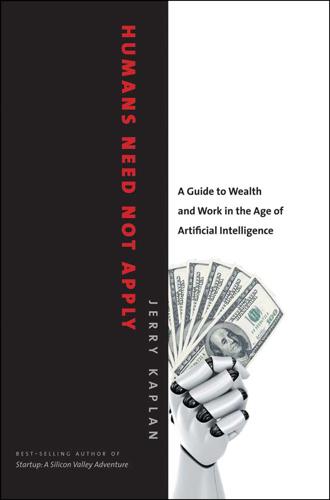
Humans Need Not Apply: A Guide to Wealth and Work in the Age of Artificial Intelligence
by
Jerry Kaplan
Published 3 Aug 2015
Others would counter that this will impede the “entrepreneurial spirit” by reducing the rewards for risk taking and hard work.15 Some would point the finger at layabout welfare recipients. Occupy Wall Streeters might take a similarly dim view of the investment bankers of Goldman Sachs, which Rolling Stone famously referred to as a “great vampire squid wrapped around the face of humanity, relentlessly jamming its blood funnel into anything that smells like money.”16 Perhaps a new federal jobs program is the ticket, reprising Franklin Delano Roosevelt’s WPA program, which employed almost 8 million people.17 But I propose that these approaches conflate two things we should consider separately: jobs and income.
…
See market forces free speech protection, 90 Fremer, Michael, 193 Friedman, Milton, 101, 157 “The Role of Government in Education,” 157 fundamental analysis investing, 62 fundamentalists, 163 futures contract, 97 Gates, Bill, 118 GDP, 168, 176, 196 growth rate, 176 genetically modified organisms, 203 Gini, Corrado, 179 “Variabilità e mutabilità,”179 Gini coefficient, 179–80 global warming, 131, 158 Goldman Sachs, 170 Google, 48, 67, 144 government, 4, 16, 57, 58 consumer information and, 178 corporate ownership and, 14 economic incentives and, 177 job mortgage loans proposal and, 153–54, 157 public assets ownership and, 180 social welfare and, 167–70, 171, 173, 182, 183–84 government bonds, 178 GPS (Global Positioning System), 6, 22, 46, 141, 142 grocery stores, 99, 145 happiness, 164 healthcare.

Competition Overdose: How Free Market Mythology Transformed Us From Citizen Kings to Market Servants
by
Maurice E. Stucke
and
Ariel Ezrachi
Published 14 May 2020
Even after the S.E.C., Fabulous Fab, Abacus, God’s work, Carl Levin, Vampire Squids? No humility? I mean, come on. Integrity? It is eroding. I don’t know of any illegal behavior, but will people push the envelope and pitch lucrative and complicated products to clients even if they are not the simplest investments or the ones most directly aligned with the client’s goals? Absolutely. Every day, in fact.40 Of course, we see how unrestrained competition does not protect investors—whether the sophisticated client of Goldman Sachs or workers buying mutual funds, whose brokers recommended “high commission, low-yielding investments that resulted in Americans achieving returns that were about 1% lower than they should have been, costing investors about $17 billion annually.”41 Regulation alone will not change corporate culture.
…
Otherwise, as Smith noted, “You don’t have to be a rocket scientist to figure out that the junior analyst sitting quietly in the corner of the room hearing about ‘muppets,’ ‘ripping eyeballs out’ and ‘getting paid’ doesn’t exactly turn into a model citizen.” Ethical concerns have continued to overshadow Goldman Sachs and other financial institutions.42 Such a corporate culture is toxic not only to the “muppets,” but ultimately to the company itself. Compare, for example, Goldman Sachs and Vanguard Group Inc., whose business culture the business professor Thomas Davenport found from his research represents the “anti-Goldman Sachs.” Whereas Goldman’s managing directors refer to their clients as “muppets,” Vanguard does the opposite: “People there are constantly reminding themselves that the idea is to help clients make better investment decisions at the lowest possible cost.”43 Whereas Goldman people “care only about making money,” Vanguard people “don’t seem hung up on the fact that people in other firms are more highly compensated on average; they seem to find it rewarding to know they’ve done the right thing for their customers.
…
Neither their executives nor their employees can identify any other kind of purpose—and many are not interested in doing so. One extreme example is an investment bank that once took pride in its ethical organizational culture. Servicing its clients’ interests was paramount. But in one of the more famous resignation letters, Greg Smith, a Goldman Sachs executive director, described how toxic competition had eroded the financial institution’s once-prized culture: How did we get here? The firm changed the way it thought about leadership. Leadership used to be about ideas, setting an example and doing the right thing. Today, if you make enough money for the firm (and are not currently an ax murderer) you will be promoted into a position of influence.
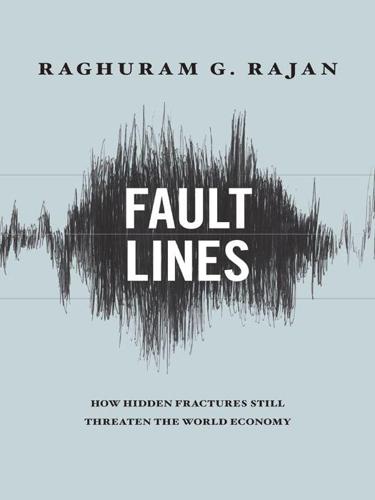
Fault Lines: How Hidden Fractures Still Threaten the World Economy
by
Raghuram Rajan
Published 24 May 2010
The public has lost faith in a system where the rules of the game seem tilted in favor of a few. Some of the bailout proposals, put together over sleepless weekends, seem poorly thought through at best and tainted by corruption at worst. Rolling Stone’s Matt Taibbi has called Goldman Sachs—a bank with alumni in every corner of the government, and, despite its protestations to the contrary, a significant beneficiary of the rescue—a “blood-sucking vampire squid.”1 The epithet seems to have stuck, epitomizing the public mood. Tin-eared bankers have not helped, paying themselves huge bonuses soon after being rescued by an ongoing public bailout, and, perhaps more infuriatingly, expressing surprised hurt at the public reaction.
…
Interestingly, even for the richest 0.01 percent of Americans toward the end of the twentieth century, 80 percent of income consisted of wages and income from self-owned businesses, and only 20 percent consisted of income from arm’s-length financial investments.11 This ratio is in stark contrast to the pattern in the early part of the century, when the richest derived most of their income from property. The rich are now the working rich—whether they are entrepreneurs like Bill Gates or bankers like Lloyd Blankfein of Goldman Sachs—instead of the idle rich. At a time when wealth seems to be within the grasp of anyone who can get a good job, it is all the more unfortunate that so many Americans, by dint of their poor education, are locked out of the productive jobs that would make them better off. I have used the term education so far, even when I refer to employability, but a better term is human capital, which refers to the broad set of capabilities, including health, knowledge and intelligence, attitude, social aptitude, and empathy that make a person a productive member of society.
…
I wrote a paper describing such incentives following bank troubles in the early 1990s, and I think the phenomenon is more widespread.13 Stan O’Neal, the CEO of Merrill Lynch, pushed his firm into the seemingly highly profitable asset-backed securities business in an attempt to keep up with rivals like Goldman Sachs. He monitored Goldman’s quarterly numbers closely and often questioned colleagues on the companies’ relative performance.14 Merrill’s lack of experience in the area eventually resulted in enormous losses and a shotgun marriage with Bank of America. The pressures on the CEO may have come not just from shareholders or personal egos but also from aggressive subordinates.

Extreme Money: Masters of the Universe and the Cult of Risk
by
Satyajit Das
Published 14 Oct 2011
Belief in myth allows the comfort of opinion without the discomfort of thought.”45 In 2009, Lloyd Blankfein, chairman of Goldman Sachs, described by Matt Taibbi of Rolling Stone as a “great vampire squid wrapped around the face of humanity,”46 told the UK’s Sunday Times that he was “doing God’s work.” Facing public anger, Blankfein, who earned $54 million for a year’s work just before the crisis, remained unapologetic about the firm’s behavior. In a piece of historical revisionism that Joseph Stalin would have admired, Goldman Sachs claimed that it never needed government assistance and would have survived the crisis without it.47 As old communists knew, it is difficult to know what will happen yesterday.
…
Competition limited CitiGroup’s gains. Other commercial banks built or bought investment banks to compete. i-Banks, the new buzzword for investment banks, shamelessly derivative of Apple’s ‘i’ products—particularly Morgan Stanley, Goldman Sachs, and Merrill Lynch (collectively dubbed MGM)—changed their business models to match the universal banks. At an internal conference in the early 1990s, John Thornton, a Goldman Sachs managing director, outlined a business model. Eschewing the traditional PowerPoint presentation, Thornton used a felt pen to draw dots on a white board. “These are the important people in the world.” Thornton then drew overlapping circles around the dots.
…
The world of finance hails the invention of the wheel over and over again, often in a slightly more unstable version.11 The Economist summarized the era: Over the past 35 years it has seemed as if everyone in finance has wanted to be someone else. Hedge funds and private equity wanted to be as cool as a dot.com. Goldman Sachs wanted to be as smart as a hedge fund. The other investment banks wanted to be as profitable as Goldman Sachs. America’s retail banks wanted to be as cutting-edge as investment banks. And European banks wanted to be as aggressive as American banks.12 They would all end up wishing they could be back precisely where they started. Elite athletes sometimes use drugs to boost performance.

Who Owns England?: How We Lost Our Green and Pleasant Land, and How to Take It Back
by
Guy Shrubsole
Published 1 May 2019
Labour’s manifesto promised for the first time to consider a land value tax, showing that the resurgence of interest in land spanned the political spectrum. There is still a long way to go. Despite the government’s manifesto commitment, Ordnance Survey’s hold over mapping licences makes it very hard to properly map land ownership in England. To Anna Powell-Smith, my collaborator on whoownsengland.org, OS remains ‘the great vampire squid wrapped around the face of UK public-interest technology’. And although it has now released details of the one-third of land in England and Wales owned by companies and public sector bodies, the Land Registry remains resistant to overcoming the final taboo: publishing the details of the private landowners who own the remaining two-thirds.
…
be a massive step Catharine Banks, ‘Briefing: The case for greater land market transparency’, Shelter, November 2016, http://england.shelter.org.uk/professional_resources/policy_and_research/policy_library/policy_library_folder/briefing_the_case_for_greater_land_market_transparency Housing White Paper DCLG, ‘Fixing our broken housing market’. For a discussion of the Land Registry-related elements of this, see https://whoownsengland.org/2017/02/08/thanks-to-the-housing-white-paper-an-open-land-registry-is-now-much-closer/ the great vampire squid Anna Powell-Smith, ‘How to use Land Registry data to explore land ownership near you’, 14 March 2016, https://anna.ps/blog/how-to-use-land-registry-data-to-explore-land-ownership-near-you 3. THE ESTABLISHMENT: CROWN AND CHURCH Queen Victoria bought Helen Walch, Sandringham: A Royal Estate for 150 Years (The Sandringham Estate, 2012).
…
In 1986, with the City of London booming in the wake of financial deregulation by Margaret Thatcher’s government, the Church Commissioners sold a 250-year lease on the land to a consortium of property developers. The deal was worth tens of millions to the Church, who also retained the valuable freehold. Goldman Sachs and the London Stock Exchange would later take up residence in Paternoster Square, transforming it from a place where monks once clutched their rosaries into a temple to modern capitalism. But it wouldn’t be long before the square was filled with the sound of chickens coming home to roost. In the wake of the financial crash of 2008 – the inevitable consequence of City deregulation – Paternoster Square was where the Occupy movement of 2011 first tried to set up camp, before being forced to settle on the steps of St Paul’s.
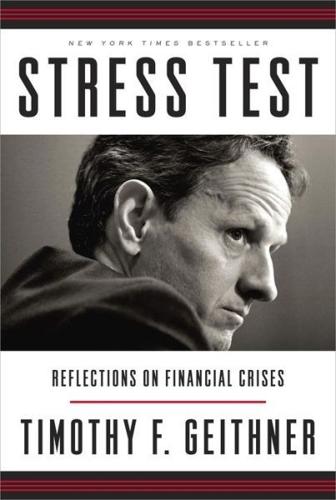
Stress Test: Reflections on Financial Crises
by
Timothy F. Geithner
Published 11 May 2014
In a futile gesture against the overwhelming consensus, I did call a New York Times editor to complain about a damaging story portraying the AIG rescue as a backdoor bailout for Hank’s former colleagues at Goldman Sachs. I had asked Lloyd Blankfein about Goldman’s direct exposure to AIG; when he assured me Goldman’s exposures were relatively small and fully hedged, I made him send me the documentation. Still, the Times wouldn’t correct the record, and my call probably strengthened its suspicions. The same reporter later did a story portraying the entire crisis response team as servants of Goldman, accompanied by a vampire squid–like diagram with me in the middle. In the media, in the public, even in the financial community, we faced withering skepticism about our motives as well as our competence.
…
Our critics didn’t explain how we could have imposed haircuts—many counterparties weren’t even U.S. firms—or why haircuts (or even protracted negotiations over haircuts) wouldn’t have produced downgrade and default. They simply found it obscene that our payouts to AIG flowed straight to financial giants such as Goldman Sachs. They didn’t have better solutions; they just didn’t like ours. We were often vulnerable to that kind of attack, because we rarely had good options. We just tried to choose the least-bad ones. Goldman Sachs was a particular lightning rod, because Hank and the chairman of my board, Steve Friedman, had both run Goldman, while one of Hank’s top aides on AIG issues, Dan Jester, and my markets chief, Bill Dudley, were former Goldman executives.
…
And yes, the financial system is alive and flourishing again. That’s partly because of the strategy I helped design and execute, which is why I’m often described as a “Wall Street ally.” The New York Times once did an amusing story about my unearned reputation as a “Wall Street insider.” People still seem to think I cut my teeth at Goldman Sachs. But nothing we did during the financial crisis was motivated by sympathy for the banks or the bankers. Our only priority was limiting the damage to ordinary Americans and people around the world. During the crisis, we did a lot of things that would be unthinkable in normal times in a capitalist economy.
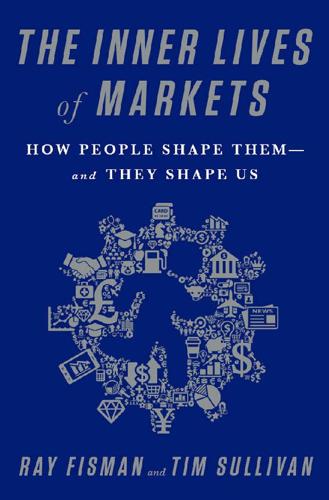
The Inner Lives of Markets: How People Shape Them—And They Shape Us
by
Tim Sullivan
Published 6 Jun 2016
Even better, why leave any ambiguity about the link between your displays of charity and your commercial interests when you can donate a portion of company profits to the church or some other charity? Lots of businesses publicly trumpet their philanthropic commitments, generally in areas that have nothing to do with the products they sell: Goldman “Vampire Squid” Sachs—blamed by many for helping to fleece investors during the financial crisis—funds an initiative to help poor African women become entrepreneurs. Target builds school libraries. GE funds community health centers. And we’re not talking chump change, either: companies are spending hundreds of millions of dollars apiece to make the world a better place, and then even more to tell us about it.12 There are surely many reasons why companies act like do-gooders (and want everyone to know it): Milton Friedman, a champion of free-market economics if there ever was one, argued that it’s primarily the result of corporate executives frittering away shareholder dollars on their own pet charities.
…
If Akerlof’s lemons model illuminated how information gaps can make markets disappear, the signaling model of Michael Spence—built on the foundations laid down by Akerlof—explains one way that buyers and sellers can save the market. As a result, we now better appreciate why the San Fers and other gangs insist on permanently marking new members, why Goldman Sachs and McKinsey recruit Harvard philosophy majors, and why profit-focused corporations “burn money” by giving to charity. Cheap Talk Compare Torres’s tattoos to some other signs of commitment: the phrase “I love you” spoken above some club music at 2 a.m., or “Trust me” in an e-mail from a Nigerian “prince.”
…
Vickrey’s 1961 paper, along with refinements supplied by Edward Clarke and Theodore Groves in the early ’70s, provided a sealed-bid mechanism that could easily be extended to work for more than one item. That meant its applications weren’t limited to unique items like epic poems or baseball superstars; it could, in theory, be used by a milk-marketing board to sell off its members’ output (this was the type of application Vickrey envisioned), or to auction Treasury bills to Goldman Sachs and J.P. Morgan. In what’s called a multiunit Vickrey auction, the task facing bidders remains much the same, but instead of providing a single number in their sealed envelopes, prospective buyers would list a bid schedule providing a separate figure for what they’d be willing to pay, depending on how many units they receive.
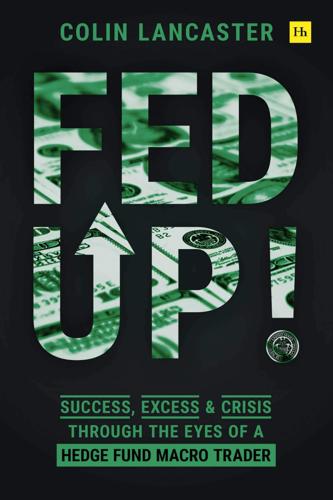
Fed Up!: Success, Excess and Crisis Through the Eyes of a Hedge Fund Macro Trader
by
Colin Lancaster
Published 3 May 2021
Do you not think that every fucking computer in the world is trained to sell stocks the minute that tapering, the exit, is announced? * I decide to walk home after the market closed. It’s a nice night. As I walk, I think. Wall Street traders used to be the big swinging dicks. The guys at Solly, then Milken’s crew at Drexel, and then Goldman took things up a notch. Back in its vampire squid days, Goldman ruled the world. It had the best proprietary trading operation in the world. It called people muppets and used to rip people’s faces off. The firm had all the advantages: created the instruments, sold them to you, knew where all the bonds were, knew what you owned, front-ran your orders, saw all of the flows, and took the most risk.
…
The highway into the city looks like a war zone, and the car I’m in feels as if it has no shocks or suspension. Shit. I can barely hold my phone to my ear there are so many bumps, and my AirPods are in my luggage. An hour and a half later, I’m finally downtown. It’s such a pain in the ass to get downtown. Now it’s almost 4 p.m., so no point checking into the hotel. I head to Goldman Sachs. All of these market events are on my mind, and I’m in New York to try to get a fresh perspective. But the negatives are tough to shake, and the Goldman guys I meet with all agree. There are a lot of problems. But everyone seems convinced of one thing: that stocks are going higher because of the Fed.
…
Peter’s Basilica has been shuttered during Lent; even salvation is on hold for the virus. Manufacturing data from China has shown its steepest decline on record. The virus is bringing activity to a standstill. Economists in the USA are busy slashing forecasts in anticipation that activity will slow substantially in the next six months. Goldman Sachs now anticipates 0% growth; it’s a cutesy forecast. Nobody can model this mess with any amount of accuracy. It’s only a statement of severity, and an ugly one at that. The one thing keeping the market from moving even lower is a growing sense that we are about to see coordinated easing by global central banks.
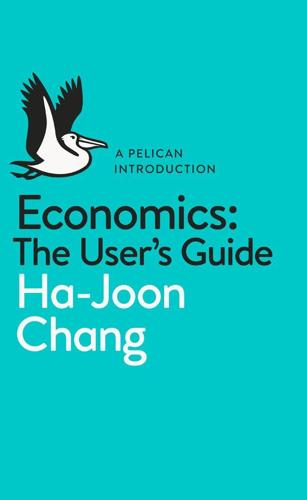
A Pelican Introduction Economics: A User's Guide
by
Ha-Joon Chang
Published 26 May 2014
Or it could be one company engaged in both, using different brands: JP Morgan Chase has an investment banking arm, using the brand of JP Morgan, and a commercial banking arm, using the brand of Chase Manhattan. Other investment banks – Goldman Sachs, Morgan Stanley, the now-defunct Lehman Brothers, etc. – do not have commercial siblings. Most of us have heard of them – especially Goldman Sachs, who have been infamously likened to a ‘vampire squid’ by the journalist Matt Taibbi – but don’t fully understand what they do. Investment banks have existed since the nineteenth century – sometimes as independent entities but often as parts of universal banks that perform both types of banking.
…
For example, reflecting the strength of the US financial industry, during the last thirty-two years (between Ronald Reagan’s first presidency, 1981–5, and Barack Obama’s first, 2009–13), six out of the ten holders of the US treasury secretary position (collectively in office for 21.5 years) had worked in the financial industry.2Two of them – Robert Rubin and Hank Paulson – had worked for one firm, Goldman Sachs. The common point in all these theories is that the government is controlled and influenced by individuals who are like all other individuals – they are selfish. It is naive, if not exactly delusional, to expect them to put public interests before their own. The government may not be able to correct for market failures, even if it wants to, due to asymmetric information and resource constraints In addition to questioning the motives of the government – or, rather, of those who control the government – the government failure argument questions whether it is even capable of correcting for market failures, even in the unlikely case of it genuinely wanting to improve social welfare.
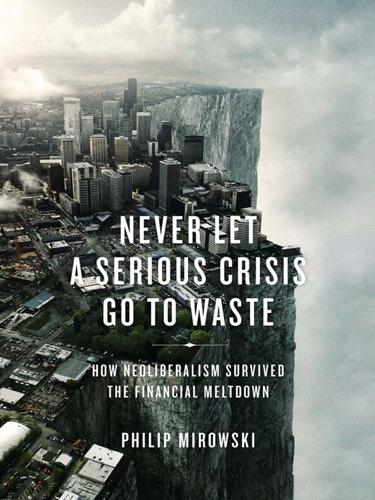
Never Let a Serious Crisis Go to Waste: How Neoliberalism Survived the Financial Meltdown
by
Philip Mirowski
Published 24 Jun 2013
Taibbi, Matt. “Glenn Hubbard Leading Academic” Rolling Stone blog, December 12, 2012 at: www.rollingstone.com/politics/blogs/taibblog/glenn-hubbard-leading-academic-and-mitt-romney-advisor-took-1200-an-hour-to-be-countrywides-expert-witness-20121220. Taibbi, Matt. Griftopia: Bubble Machines, Vampire Squids, and the Long Con (New York: Spiegel & Grau, 2010). Taibbi, Matt. “The Real Housewives of Wall Street,” Rolling Stone, April 12, 2011. Talbot, Margaret. “Brain Gain,” The New Yorker, April 27, 2009. Tankersley, Jim, and Michael Hirsh. “Neo-Voodoo Economics,” National Journal, May 20, 2011.
…
This was deployed in a myriad of ways to suggest what might seem a string of strident non sequiturs: for instance, some neoliberals actually maintained that the solution to perceived problems in derivatives and securitization was redoubled “innovation” in derivatives and securitization, and not their curtailment.108 Another variant on the Hayekian credo was to insist that the best people to clean up the crisis were the same bankers and financiers who created it in the first place, since they clearly embodied the best understanding of the shape of the crisis. The revolving door between the U.S. Treasury and Goldman Sachs was evidence that the market system worked, and not of ingrained corruption and conflicts of interest. [12] The neoliberal program ends up vastly expanding incarceration and the carceral sphere in the name of getting the government off our backs. Members of the Mont Pèlerin Society were fond of Benjamin Constant’s adage: “The government, beyond its proper sphere ought not to have any power; within its sphere, it cannot have enough of it.”
…
When he filed his “Executive Branch Financial Disclosure Report” on January 20, 2009, listing a net worth of $17–$39 million, he prompted a flurry of newspaper and blog accounts of his outsized speaker fees and favors done for the financial sector from the late 1990s onward.93 Summers has enjoyed an extremely checkered career in many respects, dating from his controversial tenure as chief economist at the World Bank in 1990, but had nonetheless risen to political prominence due to the long-term patronage of Robert Rubin, formerly co-chair of Goldman Sachs, secretary of the Treasury, and later gray eminence at Citigroup and other Wall Street institutions. During the Clinton administration, Rubin and Summers played a now-infamous role in quashing Brooksley Born at the CFTC in 1998 when she proposed reining in the proliferating markets in credit default swaps.
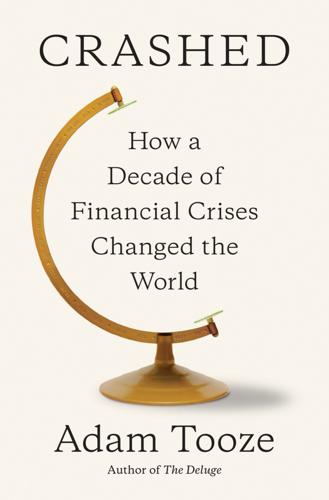
Crashed: How a Decade of Financial Crises Changed the World
by
Adam Tooze
Published 31 Jul 2018
Clinton’s answer was that Dodd-Frank should be rigorously enforced. This teed up Sanders to ask whether Clinton’s reticence had anything with the $600,000 in fees she had collected giving speeches for Goldman Sachs. Would she release the transcripts?9 For the Left, Clinton’s Goldman Sachs speeches were what her Libya e-mails were for her opponents on the Right: a further sign of her untrustworthiness. How deeply was Clinton entangled with the bank now better known as the “vampire squid”?10 Even the New York Times called for Clinton to release the text of the speeches. Weighing the issue, her campaign managers decided that Clinton’s words were not, in fact, fit for public consumption.
…
The belief in the ability to manage risk inspired by the new derivative instruments, combined with access to the institutional cash pools, enabled them to scale up their size, creating the “New Wall Street.”31 Firms like Goldman Sachs, Morgan Stanley and Merrill Lynch went from obscurity to star status. Originally built as partnerships, the huge scaling up of trading activity and the derivatives business meant that they needed to issue shares and go public. Merrill Lynch had done so already in 1971. Bear Stearns followed in 1985, Morgan Stanley in 1986. Goldman Sachs was the last to launch its IPO in May 1999.32 With Robert Rubin a classic exponent of this new Wall Street, the investment banks even had their man in government. Goldman Sachs began to earn its nickname as “government Sachs.”
…
He could challenge the establishment in his electoral campaign, pillory the chair of the Fed and demonize the CEO of Goldman Sachs and win. Having won, he could then audition Jamie Dimon of J.P. Morgan for Treasury secretary and reject him in favor of a minor Goldman Sachs alumnus who was more to his liking. If you could do all these things, you clearly were king of the hill, all the better for being king by popular acclamation. That is all Trump needed and it was a story to which he returned obsessively. The revolving door that feeds government in America regularly rotates between public service and the corporate world. In firms like Goldman Sachs, the rotation is de rigueur for senior figures.
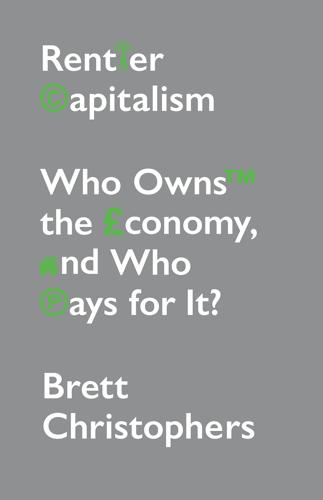
Rentier Capitalism: Who Owns the Economy, and Who Pays for It?
by
Brett Christophers
Published 17 Nov 2020
As ever more of the world’s existing economic transactions come to be mediated through platforms, and as platform operators dream up and establish new markets never before thought of, it may be the case that, by as soon as mid-century, platform rentierism will end up as one of the UK’s largest rentier domains. CHAPTER FIVE Outsourced: Contract Rents ‘The people of Goldman Sachs’, boasted the bank’s then chief executive, Lloyd Blankfein, in 2009, ‘are among the most productive in the world.’1 It was an audacious claim to make. The global banking sector itself might by that time have recovered some spring in its step after the turmoil of 2007–08, but the wider global economy, not to mention most of those working in it, had not, and banks – Goldman foremost among them – were rightly held responsible. Goldman Sachs was not, on any reasonable reckoning, productive. But statistically, at least, Blankfein was right.
…
In what follows, I draw on three examples, all of which are large and well-known contractors, including – to use the classification I introduced above – one specialist and two generalists. The specialist is BAE Systems (see also Chapter 3), a defence, security and aerospace contractor, primarily for the public sector. The generalists are two companies we have previously encountered: Serco and Capita, the latter gloriously described by Joel Benjamin as ‘the Vampire Squid of business process outsourcing, its money grabbing tentacles extending through every layer of Government, from pensions to council finance, from parking and congestion charges to NHS GP primary care support, funeral services, and even the privatised food safety agency’.50 I have already identified some of Serco’s main contracts.
…
But as UK capital has expanded its own spatial footprint, the integrity of the ‘UK economy’ has also been dissolved from the inside out – as Table 0.1 and its list of UK-based transnational enterprises well illustrates. Secondly, not all companies with a major operating presence in the UK are listed on the London Stock Exchange. Some, such as INEOS (chemicals manufacture), Greenergy (fuel supply) and John Lewis Partnership (retail), are privately owned. Others, ranging from Goldman Sachs (banking and financial services) to Google, are listed on non-UK stock exchanges. Indeed, had I compiled Table 0.1 just twelve months earlier than I did, it would have contained at least two major rentiers missing from the snapshot published here, by virtue of the fact that they were acquired in the interim by larger companies listed elsewhere: Sky, the UK media and telecommunications group, was acquired by Comcast (listed in the United States); and Shire, the UK biopharmaceuticals company, was acquired by Takeda (listed in Japan and the United States).

Rise of the Robots: Technology and the Threat of a Jobless Future
by
Martin Ford
Published 4 May 2015
In other words, the financial sector is not creating real value or adding to the overall welfare of society; it is simply finding ever more creative ways to siphon profits and wealth from elsewhere in the economy. Perhaps the most colorful articulation of this accusation came from Rolling Stone’s Matt Taibbi in his July 2009 takedown of Goldman Sachs that famously labeled the Wall Street firm “a great vampire squid wrapped around the face of humanity, relentlessly jamming its blood funnel into anything that smells like money.”54 Economists who have studied financialization have found a strong correlation between the growth of the financial sector and inequality as well as the decline in labor’s share of national income.55 Since the financial sector is, in effect, imposing a kind of tax on the rest of the economy and then reallocating the proceeds to the top of the income distribution, it’s reasonable to conclude that it has played a role in a number of the trends we’ve looked at.
…
See Earned Income Tax Credit (EITC) Elance, 95 El Camino Hospital (Mountain View, CA), 154 elder-care robots, 155–158 electricity, information technology compared to, 72–73 electronic offshoring, 59, 116 Elysium (film), 219–220, 220n email response program, 93–94 Emanuel, Ezekiel, 164 emerging economies, consumer demand in, 223–227 employment autonomous cars and, 176, 181–191 nanotechnology and, 246 offshoring and, 119–121 relationship between technology and, 175–176 3D printing and, 176, 177–181 See also unemployment Employment Policies Institute, 14 Engines of Creation (Drexler), 242, 244 ENIAC (Electronic Numerical Integrator and Computer), 32n environmental degradation, economic insecurity and, 283–284 equity endowments, 273–275 ESPN, 201 essays, machine grading of, 129–131 eugenics, 236n “Eureqa,” 108–109 Europe, college graduates overqualified for occupations in, 251 European Union, job polarization and, 50 Fabricated: The New World of 3D Printing (Lipson), 180 Facebook, xvi, 89, 92, 106, 114, 137, 152, 175, 231, 236 factory reshoring, 8–12 Fallows, James, 71 Fantastic Voyage (Kurzweil & Grossman), 235 fast food industry, 12–16, 209, 210 Fast Food Nation (Schlosser), 210 Fazzari, Steven, 199, 200, 214 Federal Drug Administration (FDA), 150n, 152, 171, 172 Federal Reserve, 218n Federal Reserve Bank of Cleveland, 44–45 Federal Reserve Bank of San Francisco, 54 feedback effects, 206, 208 Fernald, John G., 265, 266 Ferrucci, David, 99–100, 102n, 115 Feynman, Richard, 241, 243 Final Jeopardy (Baker), 96n, 102n financial crisis, debt and, 200, 214, 218–219 financial derivatives, 219 financial elite, political influence wielded by, 47–48, 59–60 financialization, 55–57 financial sector, 55–57, 103 Fluid, Inc., 103 food fabricators, 180, 246 food stamps, 201–202 Forbes (magazine), 84 “For Big Companies, Life Is Good” (Wall Street Journal), 39 Ford, Henry, 80 Ford, Henry, II, 193 Ford Motor Company, 76, 193 401k retirement plans, 222, 274 Foxconn, 10, 11, 14 fractional reserve banking, 218n France, 24, 41 Freeland, Chrystia, 51 freestyle chess, 122, 123 “freeters,” 221 “Free Trade’s Great, but Offshoring Rattles Me” (Blinder), 118 Frey, Carl Benedikt, 59, 223 Friedman, Milton, ix, 210–211 Friedman, Thomas, 133 The Gap, 17 Gates, Bill, 236 GDP (gross domestic product) consumer spending and, 199 corporate profits as share of, 40, 202, 203 finance-related activity as percentage of, 55 GDP (gross domestic product) deflator, 38n Genentech, 234 General Electric, 154, 179 General Motors, 76 The General Theory of Employment, Interest and Money (Keynes), 206 genetic programming, 108–109, 110 Georgia Institute of Technology (Georgia Tech), MOOCs and, 134–135, 142 Geraci, Robert, 235 Germany, 41 Ghayad, Rand, 45–46 globalization, 53–55, 116 glucose monitoring, 159 “Goggles” feature, 22 Gold, Jenny, 164 Goldman Sachs, 56 Good Data, 107 Google, xvi, 121, 236 Android system, 6, 21, 79, 121 artificial intelligence and, 231 autonomous cars and, xiii, 94, 182–183, 184, 186, 188, 189 big data and, 86 cloud computing and, 104, 106 cloud robotics and, 21 glucose monitor, 159 “Goggles” feature, 22 keyword-based search algorithm, 98–99 online language translation tool, 89–90, 130 personalized email and social response program, 93–94 profit and employee numbers, 76 revenue generation and, 76 robotics startup companies, acquisition of, 21n Singularity University and, 234 Thrun and Norvig and, 132 Udacity, 134 YouTube acquisition, 175 Gordon, Robert J., 65 government funding, of nanotechnology research, 242–243 government regulation of markets, 265 GPS (Global Positioning System), 209n Grabit Inc., 7–8 graphene nanotubes, 70n “gray goo” scenario, 244, 247 graying workforce, 220–223, 224 Great Recession corporate profits vs. retail sales during recovery from, 39–40, 202, 203 debt and, 200 increase in part-time jobs and, 49 jobless recovery and, 44–45, 280 productivity and, 207–208 “The Great Reversal in the Demand for Skill and Cognitive Tasks” (Beaudry, Green & Sand), 127 The Great Stagnation (Cowen), 65 Green, David A., 127 Grossman, Lev, 111 Grossman, Terry, 235 Grötschel, Martin, 71 guaranteed income.
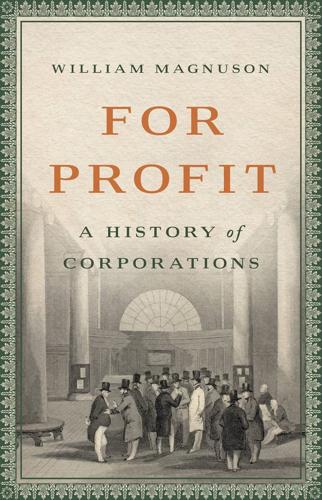
For Profit: A History of Corporations
by
William Magnuson
Published 8 Nov 2022
Complaints about individual corporations have tended to be even more colorful. Edmund Burke, writing of the East India Company, concluded that “this cursed Company would, at last, like a viper, be the destruction of the country which fostered it at its bosom.” More recently, journalist Matt Taibbi described Goldman Sachs as a “great vampire squid wrapped around the face of humanity, relentlessly jamming its blood funnel into anything that smells like money.”3 But perhaps the most enduring and devastating criticism of corporations is that they have used their profits to undermine the institutions of democracy itself. They bribe politicians to win government contracts.
…
All this led the columnist to ask, “Is Houdaille Industries… a takeover candidate?” When Kohlberg read the story, he knew that Houdaille was a perfect target for his bootstrap deal. There was just one problem: no one thought that a conglomerate company of Houdaille’s size could ever be bought in a leveraged buyout, not even Houdaille’s own investment bankers at Goldman Sachs. There was no way to raise that amount of debt from lenders. But the trio of financial whizzes at KKR thought otherwise.10 In August 1978, Kohlberg and Kravis flew down to Fort Lauderdale, Houdaille’s new headquarters, to meet Saltarelli and pitch their plan to him. They laid the charm on thick.
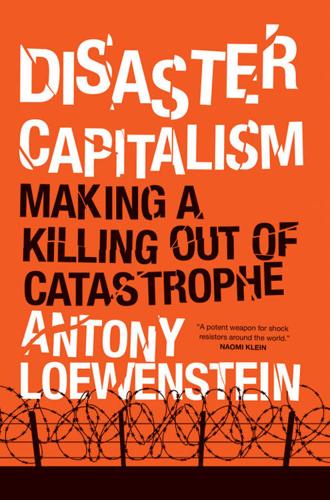
Disaster Capitalism: Making a Killing Out of Catastrophe
by
Antony Loewenstein
Published 1 Sep 2015
Solnit, Rebecca, A Paradise Built in Hell: The Extraordinary Communities that Arise in Disaster, Penguin, 2010. —. Men Explain Things to Me, Haymarket Books, 2014. Sprague, Jeb, Paramiltarism and the Assault on Democracy in Haiti, Monthly Review Press, New York, 2012. Taibbi, Matt, The Divide: American Injustice in the Age of the Wealth Gap, Scribe, 2014. —. Griftopia: Bubble Machines, Vampire Squids and the Long Con that Is Breaking America, Scribe, Melbourne, 2010. Trilling, Daniel, Bloody Nasty People: The Rise of Britain’s Far Right, Verso, 2013. Walker, Frank, The Tiger Man of Vietnam, Hachette Australia, Sydney, 2009. Notes Introduction 1Jo Confino, “It Is Profitable to Let the World Go to Hell,” Guardian, January 20, 2015. 2Peter Coy, “The Richest Rich Are in a Class of Their Own,” Business Week, April 3, 2014. 3Ned Resnikoff, “Food Pantries Stretched to Breaking Point by Food Stamp Cuts,” Al Jazeera America, November 24, 2014. 4David Leonhardt and Kevin Quealy, “The American Middle Class Is No Longer the World’s Richest,” New York Times, April 22, 2014. 5Matt Taibbi, “Bank of America: Too Crooked to Fail,” Rolling Stone, March 14, 2012. 6Matt Taibbi, “Bank of America Is a ‘Raging Hurricane of Theft and Fraud,’” Occupy Wall Street day of action, February 29, 2012. 7Justin Wolfers, “All You Need to Know About Income Inequality, in One Comparison,” New York Times, March 13, 2015 8David Halperin, “The Perfect Lobby: How One Industry Captured Washington DC,” Nation, April 3, 2014. 9Cecilia Olivet and Pia Eberhardt, Profiting from Crisis: How Corporations and Lawyers Are Scavenging Profits from Europe’s Crisis Countries (Amsterdam Transnational Institute/Corporate Europe Observatory, March 2014). 10Aditya Chakrabortty, “New Era Estate Scandal: Families at the Mercy of International Speculators,” Guardian, November 20, 2014. 11James V.
…
The sum of all executive bonuses in 2014, averaging roughly $173,000 each, came to around double the earnings of all Americans working fulltime on the minimum wage.7 It is an ideology that thrives despite guaranteeing social disharmony. The US model of reducing the role of government while increasing the influence of largely private power has never been so rapacious, though the problem is global. For-profit colleges burden students with huge debts and worthless credentials while receiving federal student aid. Goldman Sachs, a firm with a large measure of responsibility for the economic meltdown in 2008, now invests in social-impact bonds—a system that enriches the company if former prisoners stay out of jail but reduces the accountability of governments and prioritizes private profit. The corporation also makes money from higher education, pressuring underprivileged students to take on debt while giving scant attention to the standard of teaching.8 Republicans in Michigan have pushed for the privatization of public school teachers, using a skewed logic that advocates cutting public schools and selling off facilities at the lowest price.
…
35, 112–13, 139–40, 221 detention centers access 252–3, 299, 359n31 Australia 271, 274, 276, 278–9, 280–5, 285–305, 356n2, 357n11 conditions 66–71, 79, 299–304, 334n14, 357n11 costs 96, 281–3, 304 economic logic of privatization 289–99 Greece 64–71, 76, 77–80, 96, 98, 336n14 guards 64–5, 68–9 house rules 232–4 medical care 77–80, 266, 295 price-gouging 292 privatization 13, 98, 230–5, 245–51, 280–5, 289–99 racism 65, 259–60, 294 sexual abuse 252–8 size 76 staff numbers 294 staff pain and suffering 296–8 United Kingdom 230–5, 245–51, 252–8, 263–7 United States of America 211–28 workers’ health and safety 298 working conditions 297–8 Detention Watch Network 216, 222, 227–8 diabetes 14 Digicel 122 Dilley, Texas 221 disaster capitalism, definition 6–9 disaster, definition 9 disaster economics 322n18 disaster relief NGO-ization of 137–41 privatization 108–9 Droneshield 205 drones (UAVs) 97–8 drug abuse 37–9, 102 drug trade, Afghanistan 37–9 Dubai 45 Duma, William 186 Dungavel detention centre 266 Dupuy, Alex 133 Dutton, Peter 281 Duvalier, Francois (“Papa Doc”) 109–10 Duvalier, Jean-Claude (“Baby Doc”) 110–12 DynCorp 16, 26–7, 124 ecological damage, copper mining 173 Ecolog International 29 economic empowerment 162 economic exploitation, Haiti 132, 133–6 Economist 117 eco-system damage, Haiti 130 Eldorado Gold 100 Elie, Patrick 119–22 El Refugio 223 embassies, security of 30 embedded journalism 10, 26, 324n5 enlightened dictatorship 2 environmental destruction 157–8, 173, 273–4 Eppright, Fred 136 equality 311 Equatorial Guinea 14 Etienne, Yanick 126–8 Eurasian Minerals 120 Eurobank 101 European Central Bank 72 European Commission 72, 73 European Court of Human Rights 68 European External Border Surveillance System 97 European Refugee Fund 66 European Union asylum seeker numbers 96 development aid 324n3 and drones 97–8 and Greece 12 questions of identity 103–4 refugee crisis 95–8 Euro, the, Greece and 84 Evans, Tim 306 Evergreen Aviation 34 Evros 66–7 executions 199 Executive Outcomes 180 exploitation 107–8 Extractive Industries Transparency Initiative (EITI) 190–1 extraordinary rendition 16, 34 extremism 25 ExxonMobil LNG pipeline 166 Facebook 308 Fahim (Afghan engineer) 46–8 Farage, Nigel 236 Farmer, Paul 113–14, 139 fascism 85 Fatal Assistance (aid) 118–19 Ferguson, Missouri, riots in 203 Fiji 346–7n41 Financial Times 6, 191, 242 Finn, Noel 255 fiscal policy 84 Fisher, Nigel 122 Flores, Anton 223 Flynn, Michael T. 55 Fonteyne, Jean-Pierre 357n4 food aid 3, 145–6 food and drink multinationals 14 Foreign Policy 6, 45, 123 fossil fuel industry 8–9 Four Horseman International 60 fracking 8–9 France 99, 120, 311 fraud 240–1 Friedmann, Alex 216, 222 Frontex 67, 96, 97 Frontex Plus 95 Funk, McKenzie 9 Fyssas, Pavlos, murder of 90 G4S 13, 16, 23, 57, 230–5, 235, 240, 248, 255, 256–8, 258–60, 264, 277, 278, 280, 282, 283–4, 289, 290 Gaddafi, Muammar 16, 30 Gap 132 Garoute, Hans P. 147–9 Gates Foundation 202 General Atomics 31 GEO Group 124, 197, 199, 200, 201, 202, 227, 255, 266 Georgia Detention Watch 223 Georgia Latino Alliance for Human Rights (GLAHR) 224 Georgia, USA 199–200 immigrants 211–28 Stewart immigration detention centre 211–22 Germany 75, 84, 239 Gertler, Dan 120 Ghana 339n38 Ghani, Ashraf 27, 32, 45, 62 Gibney, Matthew J. 284 Gilbert, Sylvie 190 Glass, Charles 27 global capitalism, Klein’s critique of 7–8 Global Detention Project 68 global financial crisis, 2008 3, 72, 239, 309 Global Solutions Limited (GSL) 289–90 Golden Dawn 12, 71, 72, 74, 75, 78, 80, 104 aims 91–2 anti-Semitism 90–1 appeal 87 and the Greek Orthodox Church 88 iconography 89–90, 92 and immigration 88–9, 92 leadership 86, 91 Luqman trial 94 opposition 93–5 patriotism 88 popularity 85–6 and privatization 92–3 relationship with police 86 supporters 86, 87 violence 92, 94 worldview 87–93 Goldman Sachs 4 Gopal, Anand 32–3, 46–7 Gopnik, Adam 196 Government Accountability Office (US) 35 government, role of 4 Grainger 206 Grayling, Chris 261–2 Grayson, John 235, 262 Greece 4, 12, 64–104 ANEL (Independent Greeks) 73 anti-Semitism 93 asylum seeker infrastructure 66–8, 76–7 asylum seekers 64–71, 75–7, 77–80, 89 Asylum Service 66–7 austerity 71–5, 99–103, 307–8 closed hospitality centers 67–8 corruption 64, 72 debt crisis 71–5, 84 detention centers 64–71, 76, 77–80, 96, 98, 334n14 economic policies 12, 73 election, 2015 72–3, 91, 101 and the Euro 84 Eurozone exit 95 foreign investment 100–1 and Germany 75 Golden Dawn 12, 71, 72, 74, 75, 78, 80, 85–95, 104 healthcare system 80–4 Health Ministry 82 immigrants 74, 88–9, 92 immigration policy 96 medical care, asylum seekers 77–80 Ministry of Public Order and Citizen Protection 76 police brutality 83 potato movement 78 poverty rate 98–9 press freedom 74, 75 pressure on 73 privatization 72, 98, 100–2, 307–8 privatization of the detention network 77 questions of identity 103–4 racism 71, 80 reception centers 67 refugee crisis 95–8 sovereignty 104 suicide rate 102 Syntagma Square protest, 2014 70 Syriza 12, 72–5, 83, 91, 95, 103 unemployment 67, 99 Greek Council for Refugees 66 greenhouse gases 1–2 Green Prison 204 green technology, prisons 204 Greenwald, Glenn 219 Greg (PMC contractor) 60–1 Greiner, Robert 15 GTL 210 Guantánamo Bay 28, 240 Guardian 75, 261 Guatemala 134 Gulf War, First 25 Gulf War, Second 60 Gurkhas 20, 22, 25 Habib-Ur-Rahman 46–8 Hadawal, Khan Afzal 61 HADOM 140 Haidari, M.
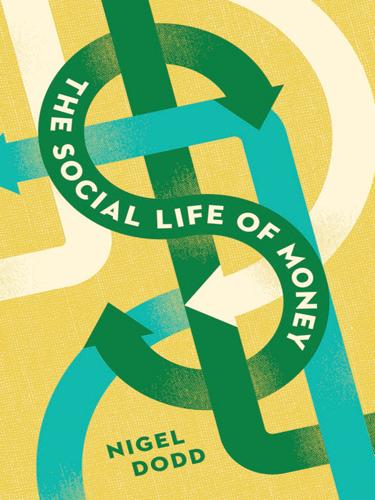
The Social Life of Money
by
Nigel Dodd
Published 14 May 2014
Max Weber and the Idea of Economic Sociology, Princeton, NJ, Princeton University Press. Swedberg, R. (2003). “Answer to Geoffrey Ingham.” Journal of Classical Sociology 3 (3): 311–14. Szabo, N. (2008). “Bit Gold.” http://unenumerated.blogspot.co.uk/2005/12/bit-gold.html, accessed November 2, 2012. Taibbi, M. (2010). Griftopia: Bubble Machines, Vampire Squids, and the Long Con That Is Breaking America, New York, Spiegel and Grau. Thaler, R. (1999). “Mental Accounting Matters.” Journal of Behavioral Decision Making 12 (3): 183–206. Thiemann, C., F. Theis, et al. (2010). “The Structure of Borders in a Small World.” PLoS ONE 5 (11): e15422. doi:15410.11371/journal.pone.0015422.
…
The breadth, severity, and complexity of the Lehman case reflected a series of structural changes within the global banking system that had been underway for some time. The major banks had been growing inexorably in size—Lehman was the fourth largest investment bank in the United States (behind Goldman Sachs, Morgan Stanley, and Merrill Lynch)—but the financial sector as a whole had been expanding relative to the real economy. In Britain at the beginning of the twentieth century, the largest three banks had assets worth 7 percent of GDP; by mid-century, the figure reached 27 percent, and by 2007, 200 percent of GDP (Haldane 2011: 10; Haldane 2012: 14).
…
See also impossible gift; true gift Girard, René, 43–44 Giscard d’Estaing, Valéry, 99 global bank, 69 global city, 241, 242–43 globalization, 66, 122, 215, 251, 279, 302; in Baudrillard, 197; and empire, 238–41; of finance, 120; in Hardt and Negri, 237–38, 241; in Harvey, 243; of money, 216, 242–43; in Sassen, 242–43 Godelier, Maurice, 390 Godschalk, Hugo, 350 Goethe, Johann, 92, 138, 211, 267, 314, 328, 331; on the primal plant, 332; on the Urphänomen, 328 Goffman, Alice, 293 gold, 42, 52, 55, 66, 96, 188, 299, 375; artificial, 56n; and banknotes, 36n; as a ‘barbarous relic,’ 22; and Bitcoin, 362, 368; and capital, 69; and credit money, 73–74; decoupled from dollar, 45–46, 99, 298; demonetization of, 74, 88; discovery of, 63; and fiat money, 62; in the First World War, 225–26; in Marx, 53, 58–59, 62–63; and the monetary base, 69; New World, 223; and paper money, 185; price of, 22; and primitive accumulation, 63, 66; and religion, 45–46; reserves of, 74; and Peter Schlemihl, 186; and the sea, 222; and slavery, 43 gold bug, 26, 185 gold standard, 22, 36n, 46, 55, 62, 73, 192, 348, 349; compared with the euro, 79; and imperialism, 73n31; in Polanyi, 280–81 golden calf, 271, 333, 340 Goldman Sachs, 114 Goldscheid, Rudolf, 321n Goldthorpe, John, 73n30 Goodhart, Charles, 15n2, 20–21 Google Wallet, 377, 378, 381 Gordon, Barry J, 93n11 gourde, 302 Goux, Jean-Joseph, 39–43, 182, 185, 191 Graeber, David, 94–102; on adornment as money, 205, 282; on bullion versus credit money, 96–97, 225n16; on the human versus commercial economy, 97; on money and violence, 96–97; on primitive accumulation, 98; on society, 101 Grameen America, 358 Grameen Bank, 357–58 grammatology, 41.